70 photos from the ’70s that show how the world was changing
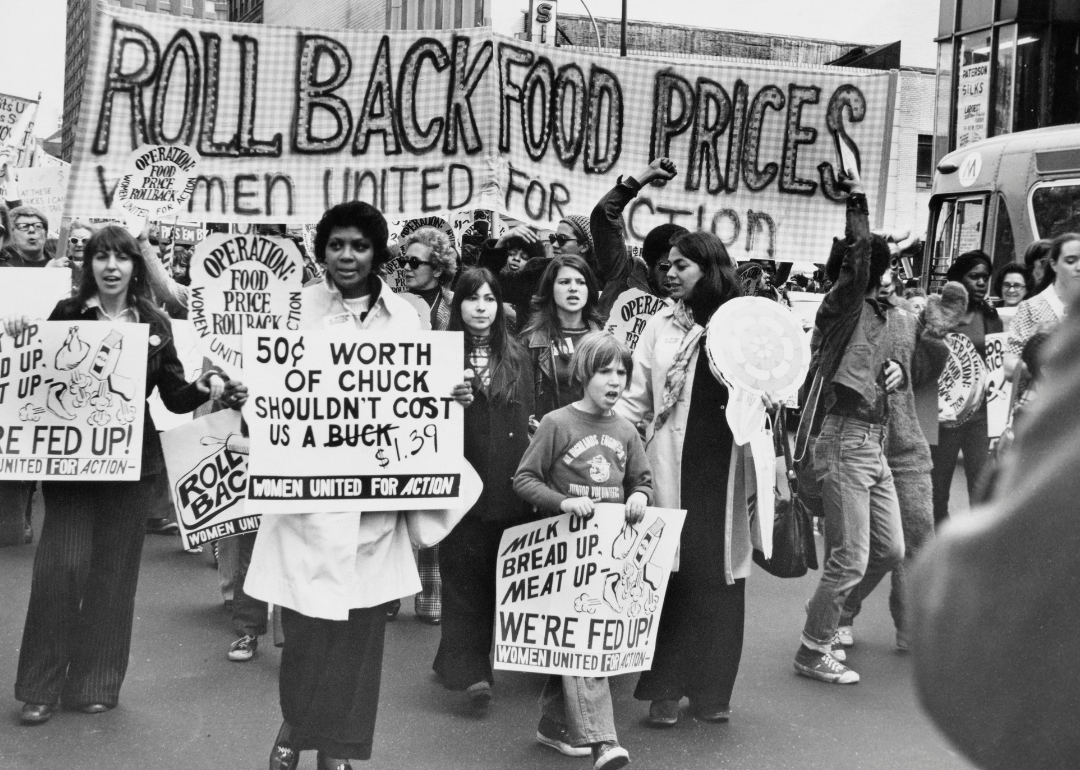
Keystone/Hulton Archive // Getty Images
70 photos from the ’70s that show how the world was changing
Women and children marching to protest the rise of food prices.
All told, the 1970s were a chaotic decade. At home, the countercultural revolution of the ’60s continued with protests against the Vietnam War and demonstrations in favor of increased women’s rights. Globally, there was also a good amount of political upheaval evidenced by the Iranian Revolution, the conflicts between Egypt and Israel, and the ongoing Cold War. But there was also this unpredicted return to more conservative roots, as seen in the formation of the “silent majority” in the United States and the election of Margaret Thatcher in the United Kingdom.
Outside of the political realm, there were major steps made in the sciences with the birth of the first test-tube baby; the increased popularity of home computers; and the various space missions, both manned and unmanned, that provided a more well-rounded understanding of the universe. Pop culture drifted away from family-friendly, wholesome content to racier and more substantial programming like “All in the Family” and “Roots.” Disco took over the nightlife scene and gave people a place to escape the oppression they often faced in the daytime, especially if they were Black or LGBTQ+.
There was a lot going on in the ’70s. And that’s just scratching the surface. To better understand one of the nation’s most formative decades, Stacker has compiled a collection of 70 images that show how the ’70s changed the world. From politics to technological developments, pop culture, and major figures of the decade, these images tell quite a story.
You may also like: Popular board games released the year you were born
![]()
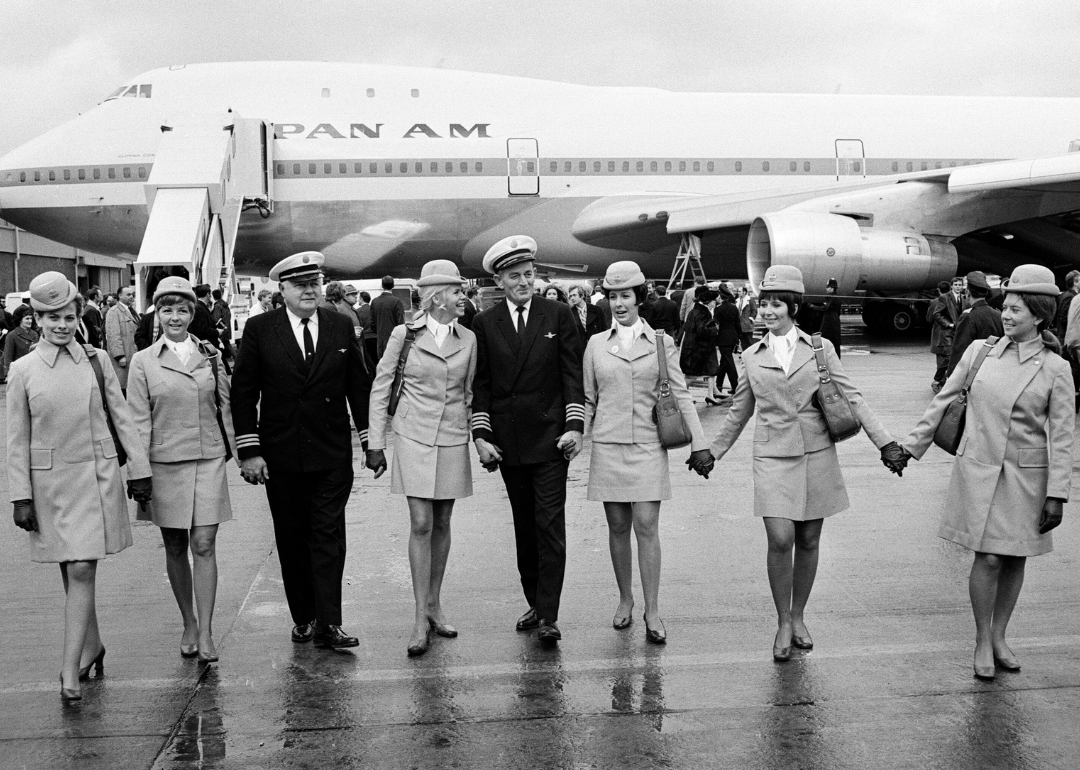
Sidey,Crawshaw&McDonald/Mirrorpix // Getty Images
Air travel goes mainstream
Pilots and crew stand in front of 747 passenger jet at Heathrow Airport.
International travel took a huge step forward when the first Boeing 747 Pan Am jet safely made the journey from New York City to London’s Heathrow Airport on Jan. 22, 1970. The wide-bodied aircraft was quick, comfortable, and affordable, making a trip across the pond more accessible for many Americans than it had been in previous years.
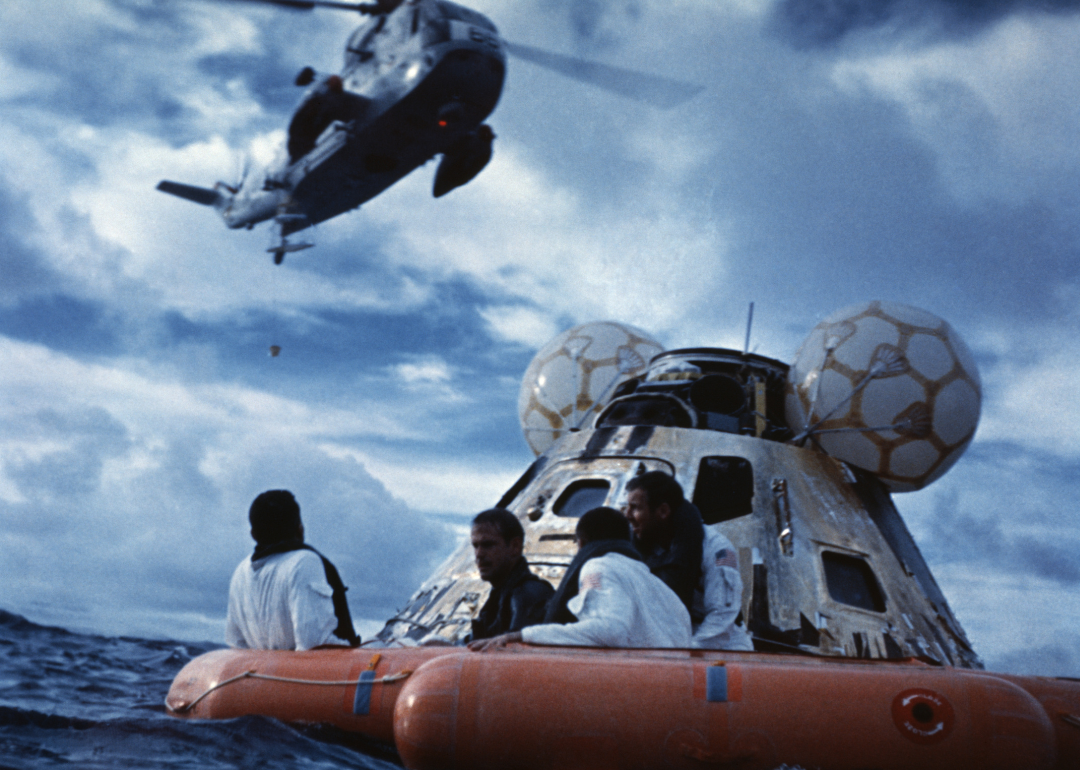
Bettmann // Getty Images
Apollo 13 arrives home
Apollo 13 Splashdown – Haise, Swigert and Lovell
In the spring of 1970, the world anxiously followed the progress of Apollo 13 after it suffered an onboard explosion on the second day of its mission. Fortunately, the astronauts operating the spacecraft made it home safely, and a naval ship was on hand to pick up the three American heroes when they dropped into the South Pacific Ocean.
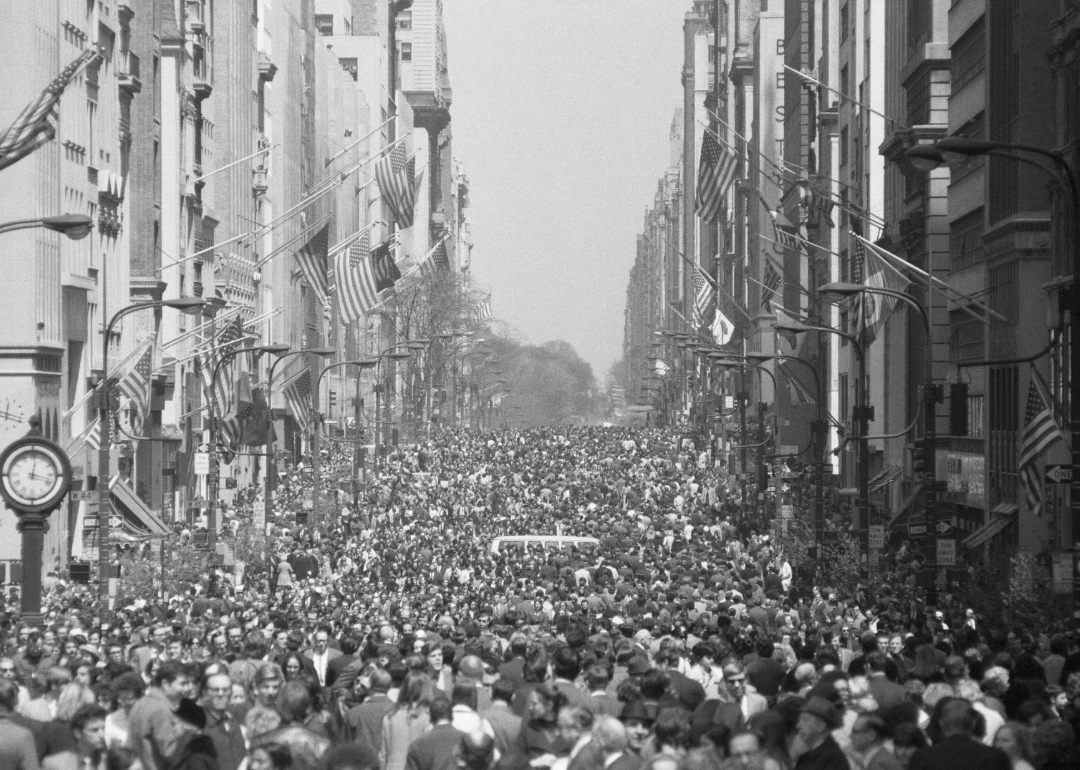
Bettmann // Getty Images
The first Earth Day
Crowds fill a carless Fifth Avenue in New York City on Earth Day.
New York City crowds pack a closed-to-cars Fifth Avenue on the first Earth Day, April 22, 1970. Now observed in 141 countries, the holiday was originally intended to bring awareness to environmental causes and oppose ecological degradation.
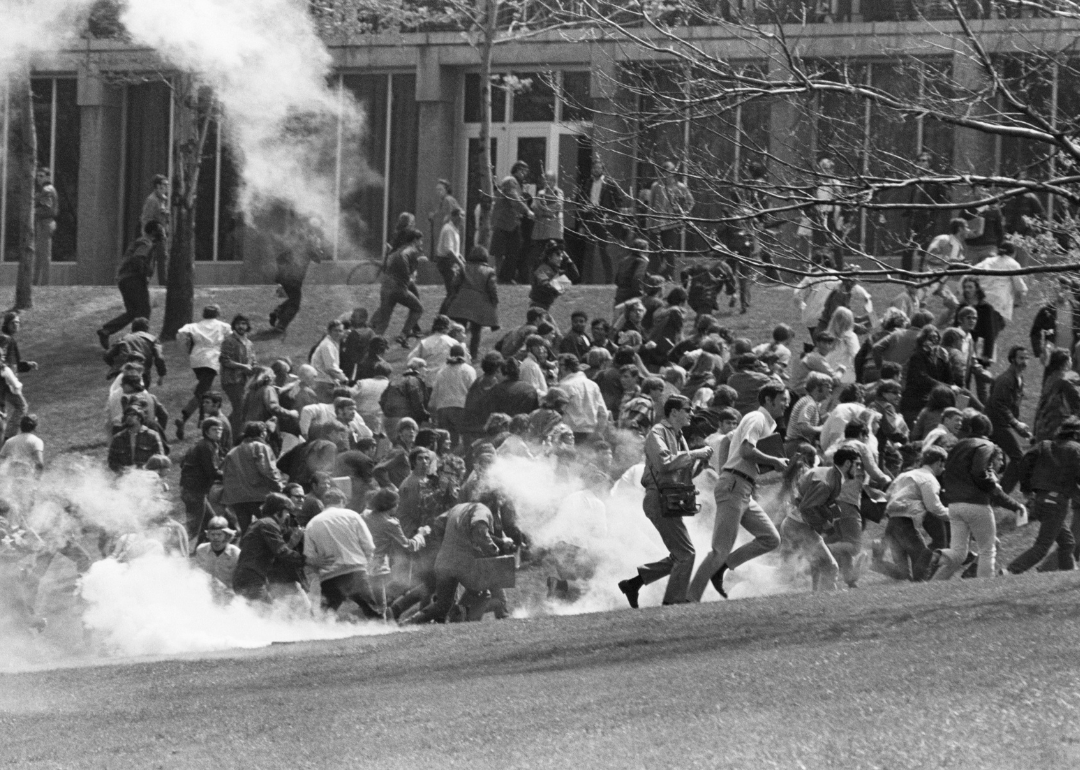
Bettmann // Getty Images
The Kent State shootings
Demonstrators at Kent State flee tear gas.
On May 4, 1970, four anti-war protesters at Kent State University were shot and killed by members of the Ohio National Guard during a peace rally. Nine other Kent State students were wounded. Here, students flee the scene as tear gas billows around them.
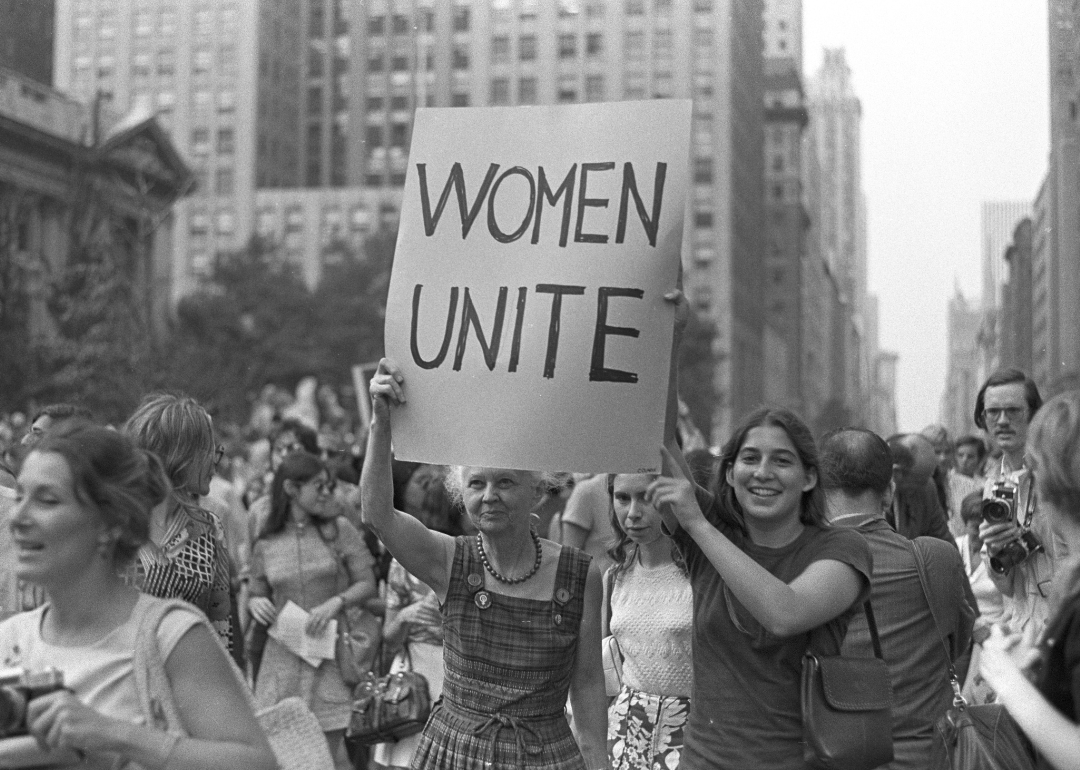
Bob Parent // Getty Images
The Women’s Strike for Equality
“Women’s Strike For Equality” in New York City.
In celebration of the 50th anniversary of the ratification of the 19th Amendment, women across America went on strike on Aug. 26, 1970. The Women’s Strike for Equality looked a little bit different in every participating city, but the biggest single event of the day took place in New York City when some 50,000 women congregated to march down Fifth Avenue.
You may also like: Black history from the year you were born
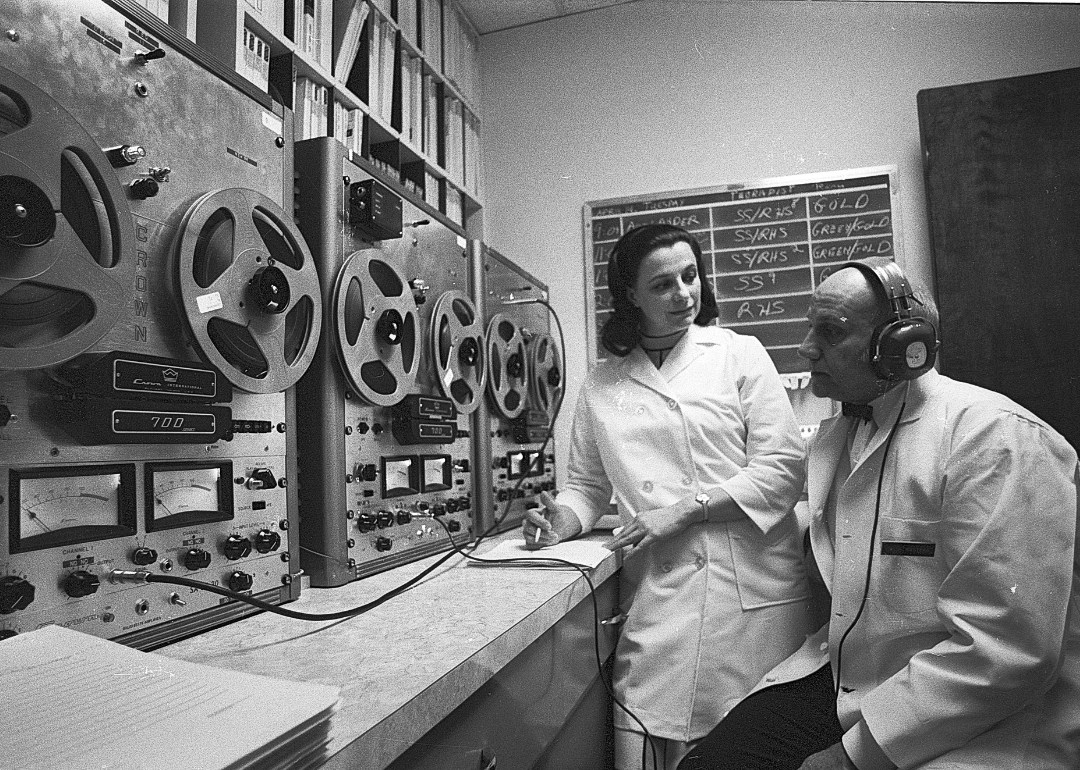
Ben Martin // Getty Images
Masters and Johnson study sexuality
William Masters and Virginia Johns pose in their St. Louis Institute.
William Masters and Virginia Johnson were just over a decade into their work researching the nature of human sexuality in the spring of 1970. Here, the pioneering duo is photographed at their Reproductive Biology Research Foundation in St. Louis, now called the Masters and Johnson Institute.
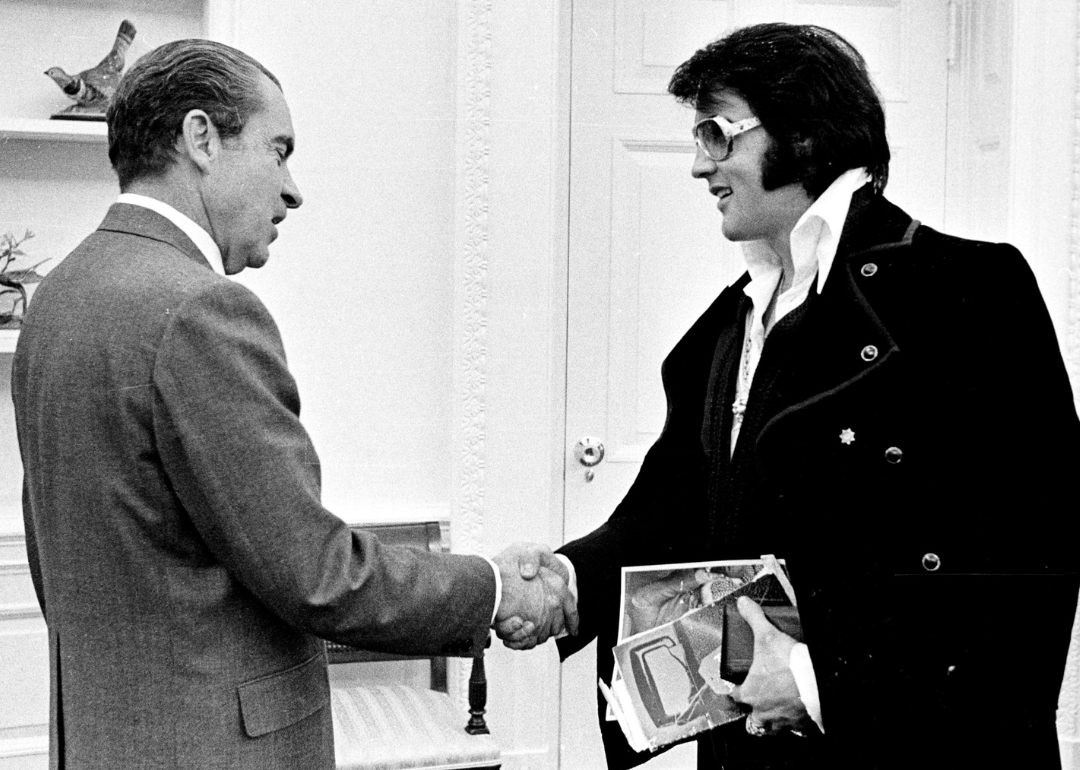
National Archive/Newsmakers // Getty Images
Elvis meets Nixon
President Richard Nixon greets Elvis Presley in the White House.
In one of the more bizarre White House moments of all time, Elvis Presley popped by the Oval Office unannounced on Dec. 21, 1970, to personally offer his services to President Richard Nixon in the war on drugs. According to the Washingtonian, images of the iconic meeting are the most-requested items from the National Archives.
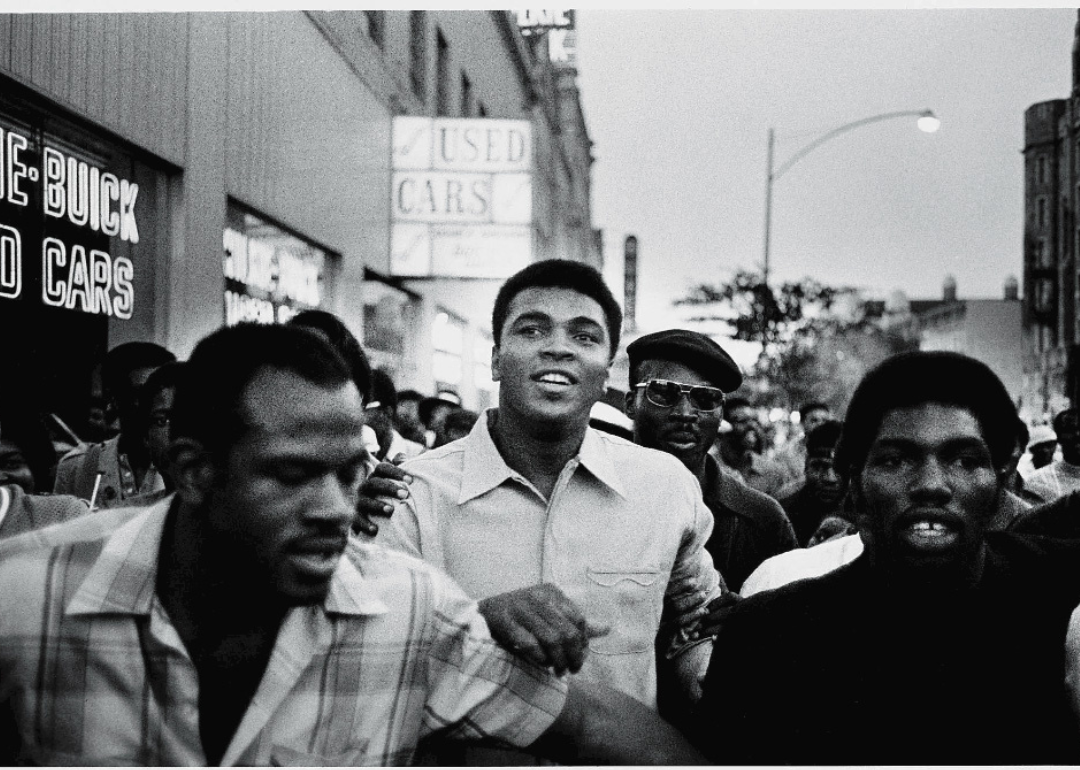
David Fenton // Getty Images
Muhammad Ali and the Black Panthers
Muhammad Ali in New York City.
Muhammad Ali and the Black Panther Party had a close relationship throughout the ’70s, though he was never an official member of the movement. Here, the legendary boxer marches with a group of Black Panthers, lending his voice to the fight for fair treatment and equal rights.
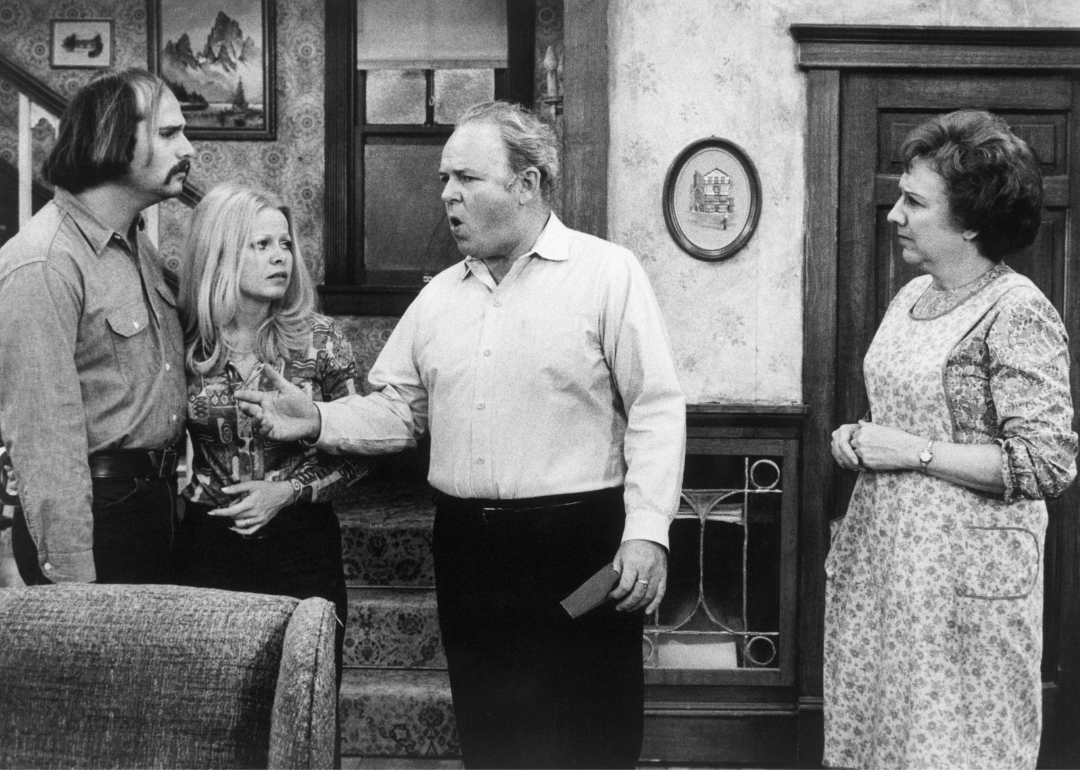
Bettmann // Getty Images
‘All in the Family’ premieres
Promotional still from ‘All in the Family’ TV series.
“All in the Family,” a sitcom following the lives of the working-class Bunker family, made its debut in early 1971. Before it wrapped in 1979, the series tackled many issues that had never been addressed on TV—racism, women’s rights, abortion, and infidelity.
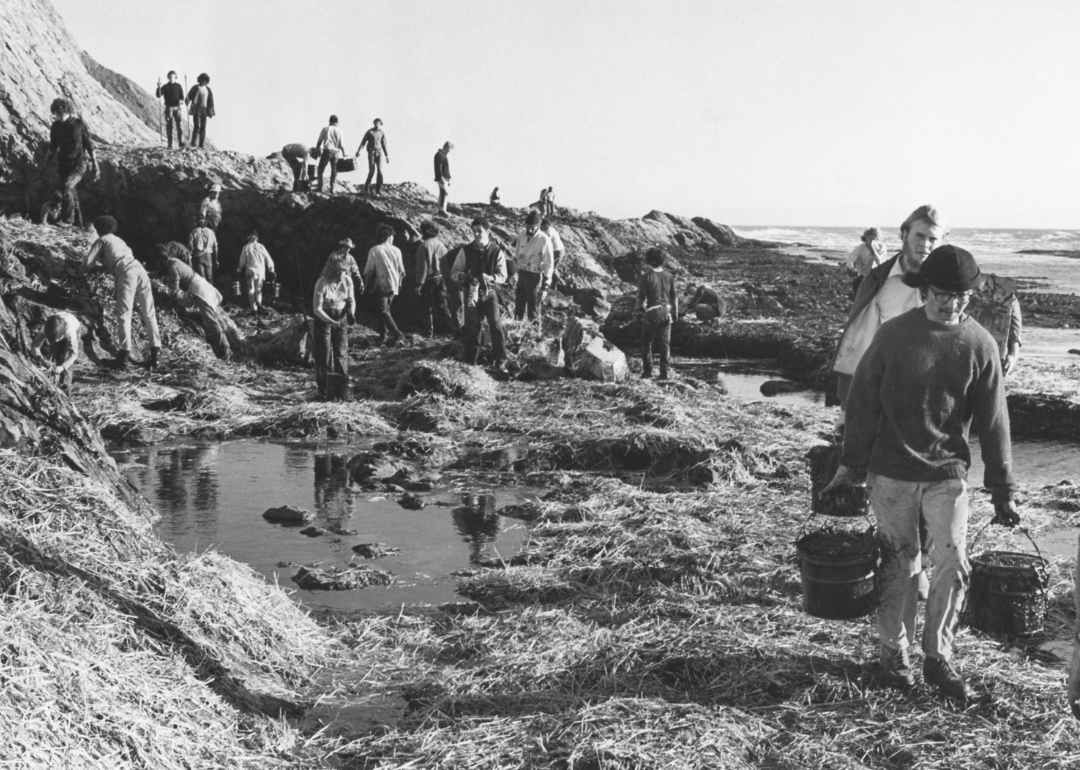
Roy H. Williams/MediaNews Group/Oakland Tribune via Getty Images
The San Francisco Bay oil spill
Volunteers clean up beach after oil spill.
In the early morning of Jan. 18, 1971, two Standard Oil tankers collided in the San Francisco Bay, spilling an estimated half a million gallons of oil. Local residents jumped in, volunteering their time to help clean the spill, and several environmental organizations, such as the International Bird Rescue, were born as a result.
You may also like: 30 bizarre inventions from throughout history
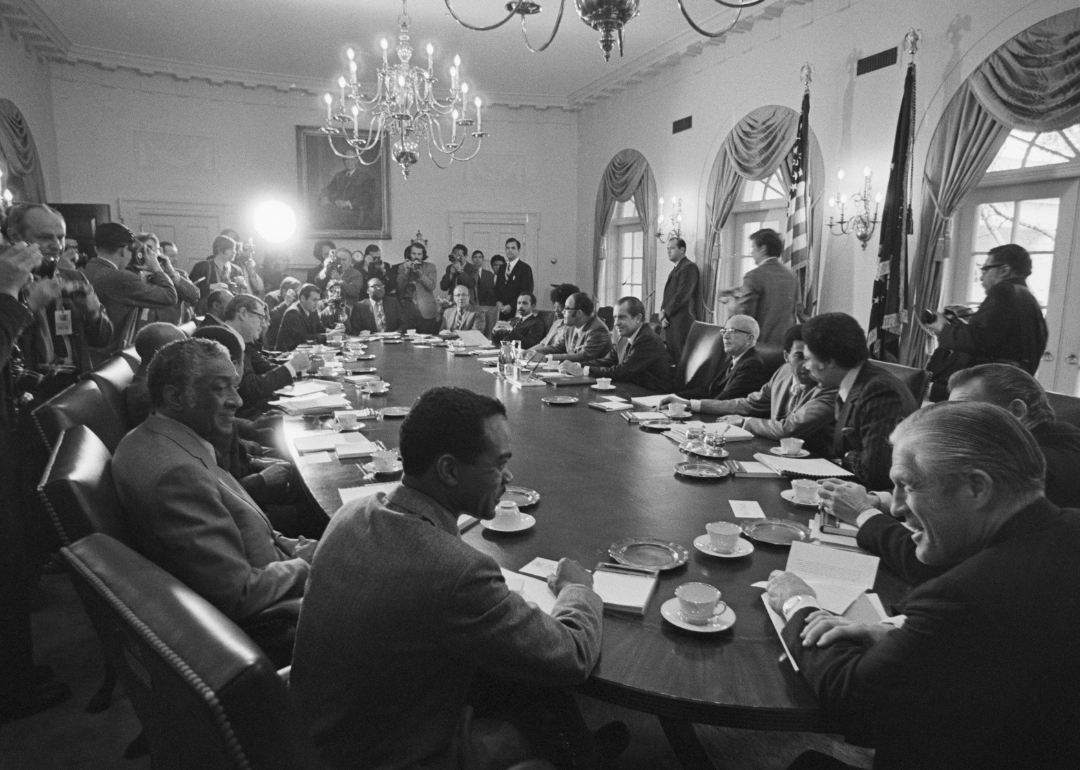
Bettmann // Getty Images
Congressional Black Caucus founded
Members of the Congressional Black Caucus meet with President Nixon.
The Congressional Black Caucus, a group focused on championing the causes that most affect Black Americans and aims to fight for increased equity for Black Americans, was founded in 1971. Here, 12 members sit down to get to work.
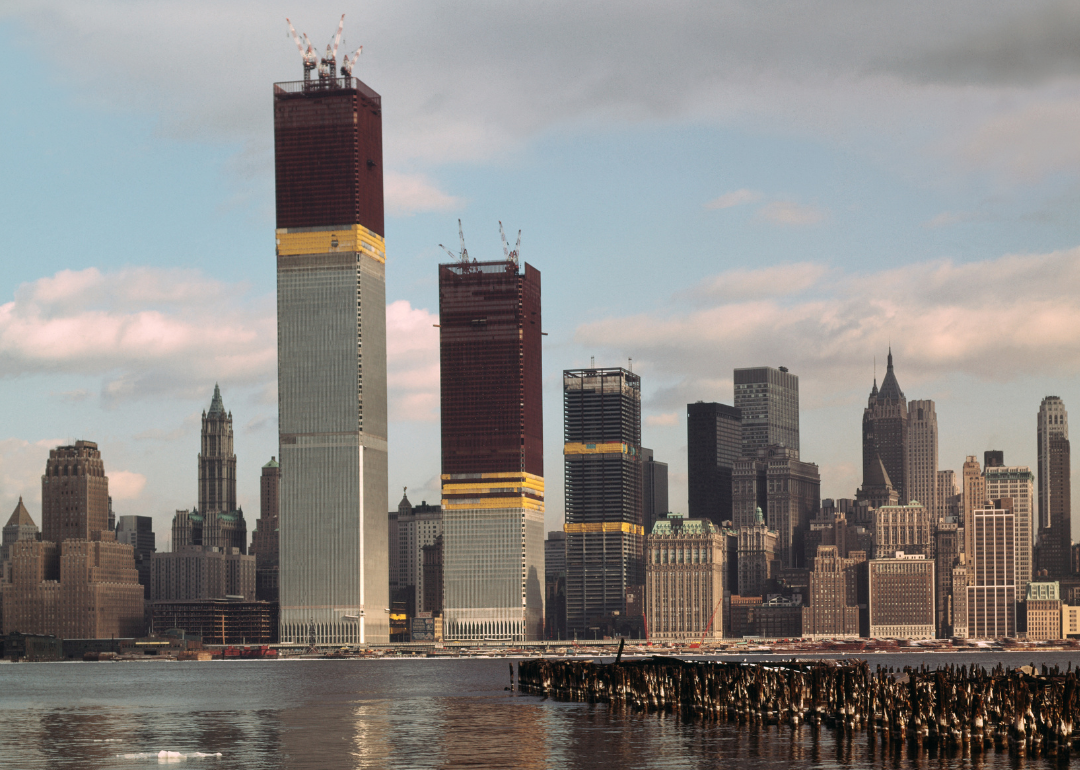
Bettmann // Getty Images
Twin Towers completed
Manhattan skyline with Twin Towers under construction.
The World Trade Center’s twin towers were both completed in the 1970s. Work on the North Tower wrapped up in December 1970, followed by the South Tower in July 1971.
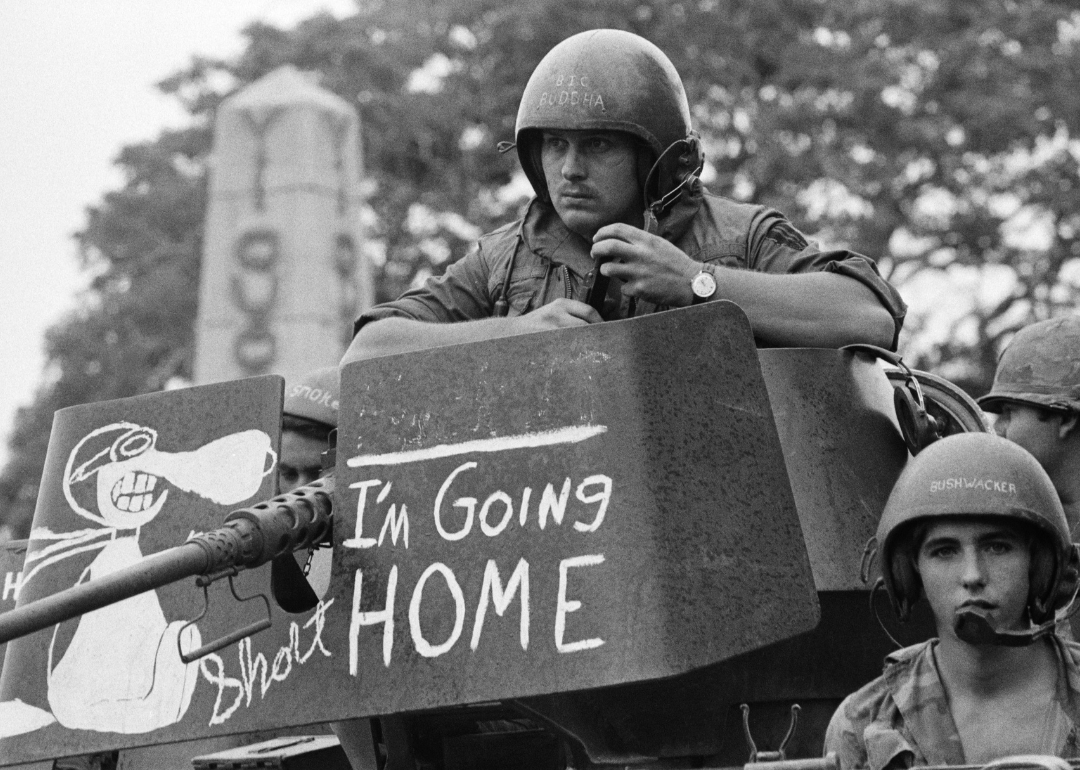
Bettmann // Getty Images
Troops began leaving Vietnam
GI looking out over tank gun mount painted with “I’m going home.”
The United States’ involvement in the Vietnam War had been controversial from the beginning, but it wasn’t until the early 1970s that the Senate actively began working against the sitting president to bring troops home. In response, President Richard Nixon started bringing troops home— like this young man—in earnest.
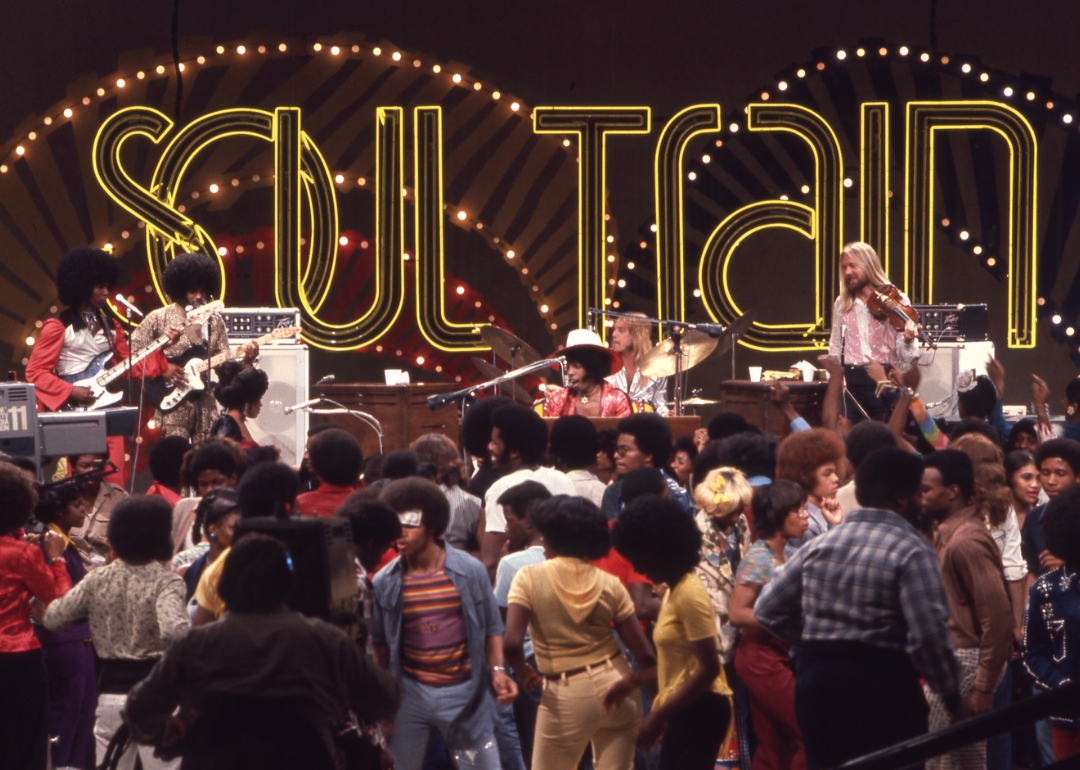
Soul Train via Getty Images
‘Soul Train’ hits the airwaves
The band ‘Sly and the Family Stone’ perform on the TV show ‘Soul Train.’
In October 1971, “Soul Train,” the iconic Black music and dance show, hit the airwaves. Here, Sly and the Family Stone perform on the show to the delight of a packed audience.
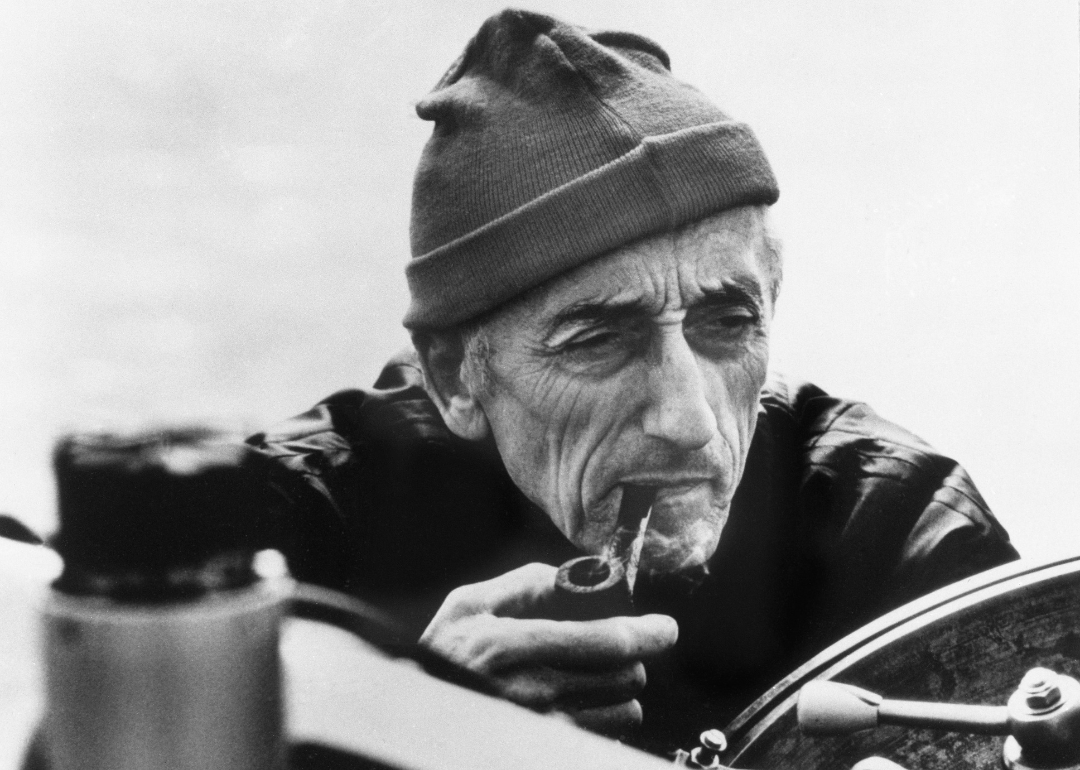
Bettmann Archive // Getty Images
Jacques-Yves Cousteau
Jacques Cousteau portrait with pipe.
Jacques-Yves Cousteau, scientist and host of the popular documentary series “The Undersea World of Jacques Cousteau,” poses on board his ship. The oceanographer established the Cousteau Society in 1973 to help protect marine life.
You may also like: 50+ years of modern LGBTQ+ history
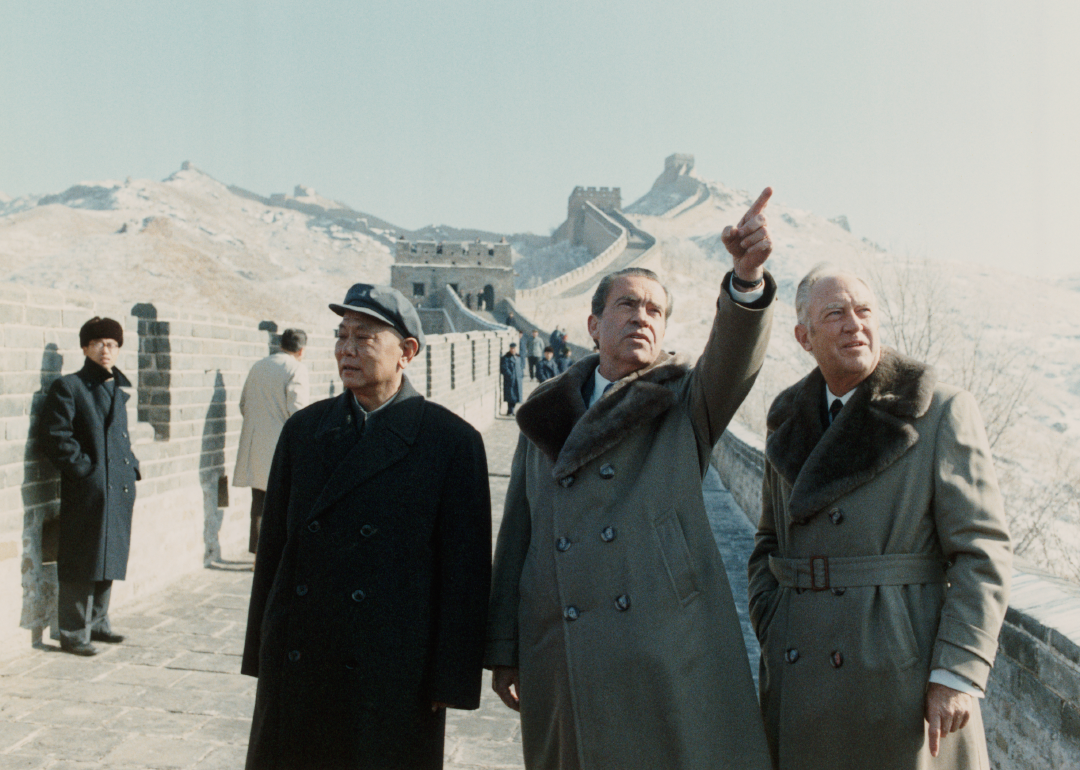
Corbis via Getty Images
Nixon visits China
President Richard Nixon visits the Great Wall of China.
In 1972, President Richard Nixon became the first sitting president to visit mainland China. His seven-day tour of the communist country has often been hailed as “the week that changed the world” thanks to its impact on international politics.
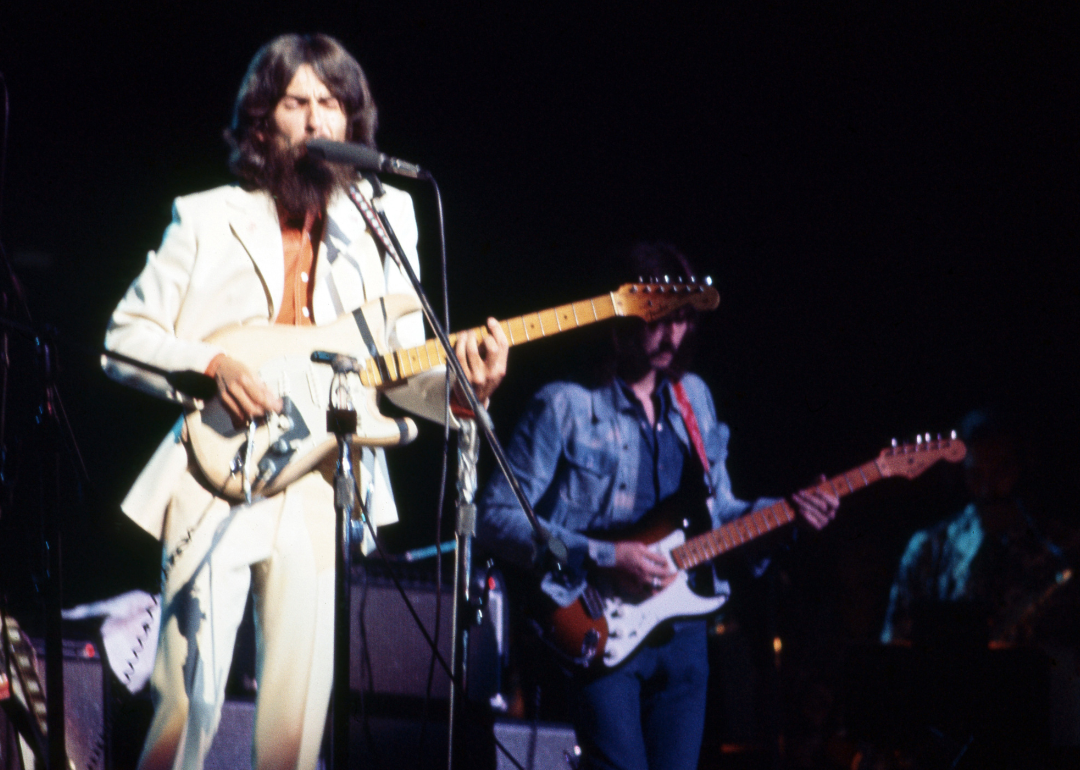
Icon and Image // Getty Images
Concert for Bangladesh
George Harrison and Eric Clapton perform at the Concert for Bangladesh.
Nowadays, massive benefit concerts are almost commonplace, but they were practically unheard of in the 1970s. George Harrison’s 1971 Concert for Bangladesh is thought to be the first of these celebrity fundraisers. In two sold-out performances, Harrison, fellow musician Ravi Shankar, and other guest performers, including Ringo Starr, Bob Dylan, and Eric Clapton, played to sold-out Madison Square Garden audiences, raising money for East Pakistani refugees fleeing the Bangladesh Liberation War.
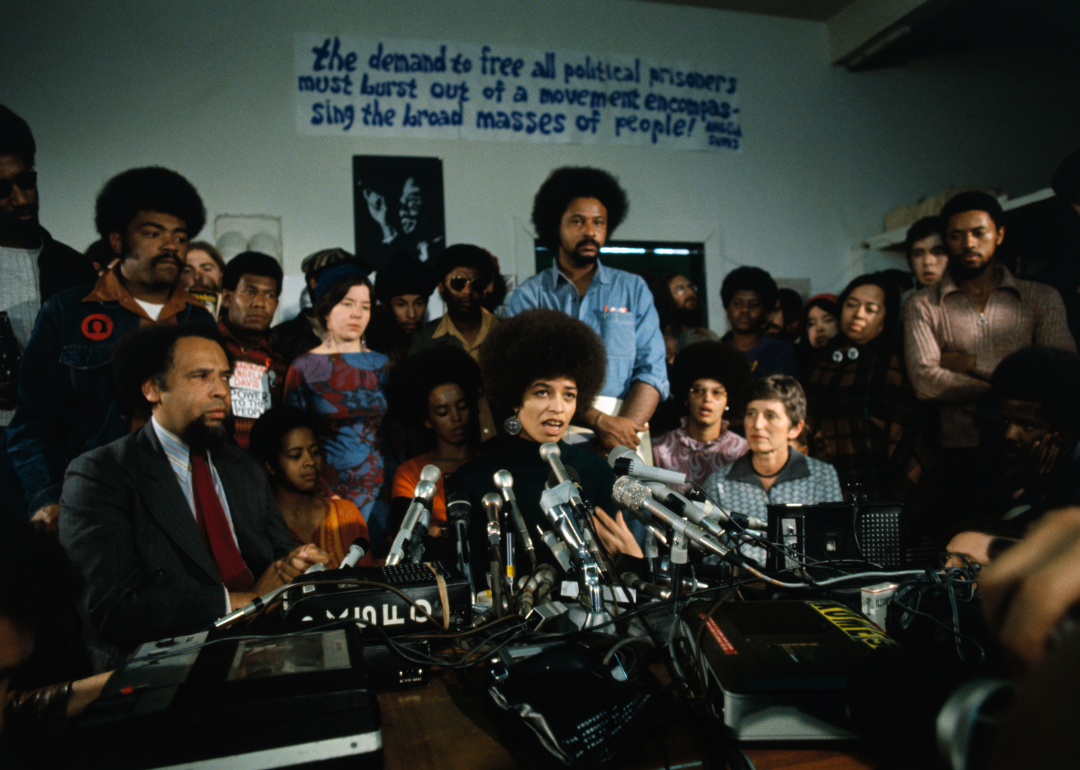
Bettmann // Getty Images
Angela Davis acquitted
Angela Davis speaks at a news conference.
In 1970, activist and professor Angela Davis was arrested for her supposed involvement in the armed seizure of Marin County’s courthouse in California. She spent 16 months behind bars before being released and acquitted in 1972. Her time in prison helped to shape her future as a staunch prison-industrial complex abolitionist.
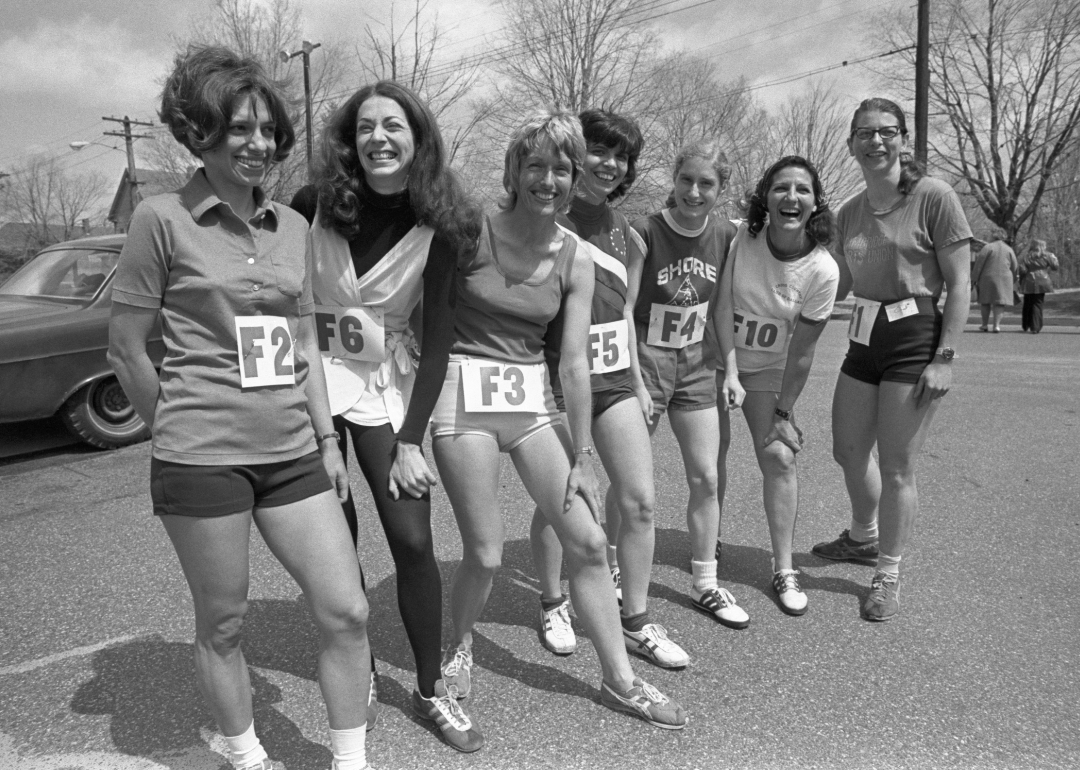
Bettmann // Getty Images
Women enter the Boston Marathon
A group of women pose for a photo before running the Boston Marathon.
Only men were allowed to participate in the Boston Marathon for the first 76 years of its existence. That all changed in 1972 when eight female participants were finally allowed to register. The winner, Nina Kuscik (on the left wearing F2) finished the race in three hours, 10 minutes, and 26 seconds.
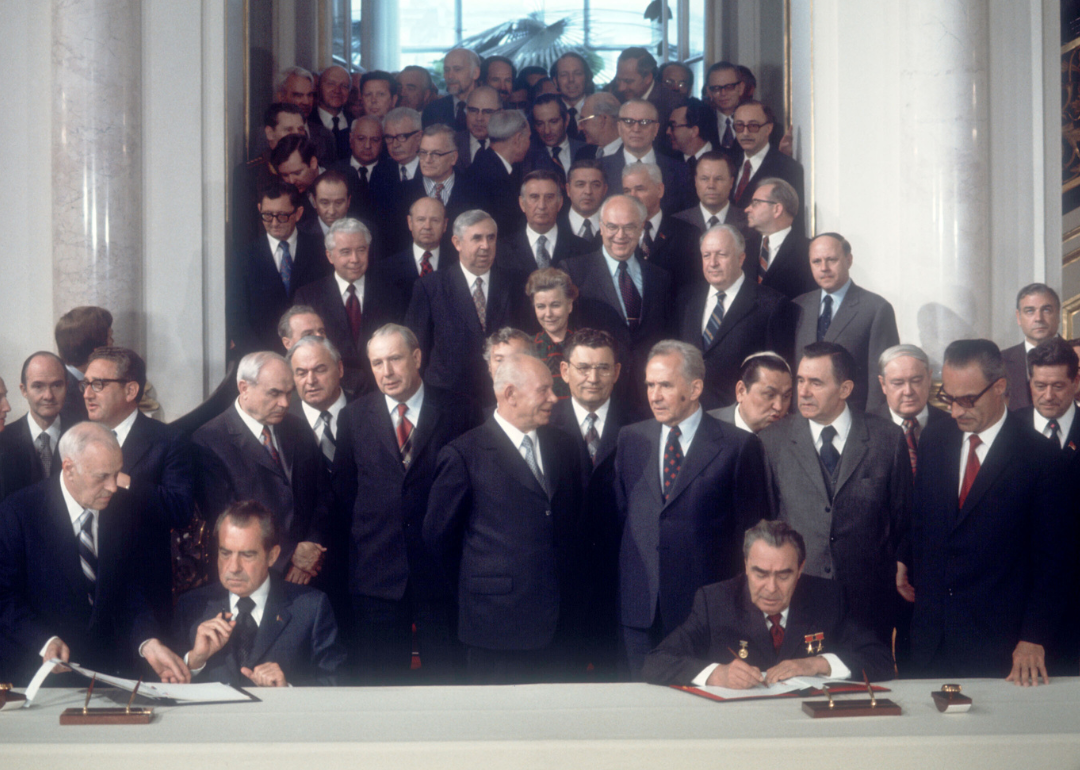
Dirck Halstead/Liaison // Getty Images
The SALT I Treaty is signed
Richard Nixon and Leonid Brezhnev sign SALT treaty.
In an attempt to tamp down some of the tension brought on by the Cold War, President Richard Nixon (seated on the left) and Soviet leader Leonid Brezhnev (seated on the right) signed the Strategic Arms Limitations Treaty I in 1972. The pact said that both countries would limit the number of missiles in their arsenals.
You may also like: Women’s fashion trends from the past 100 years
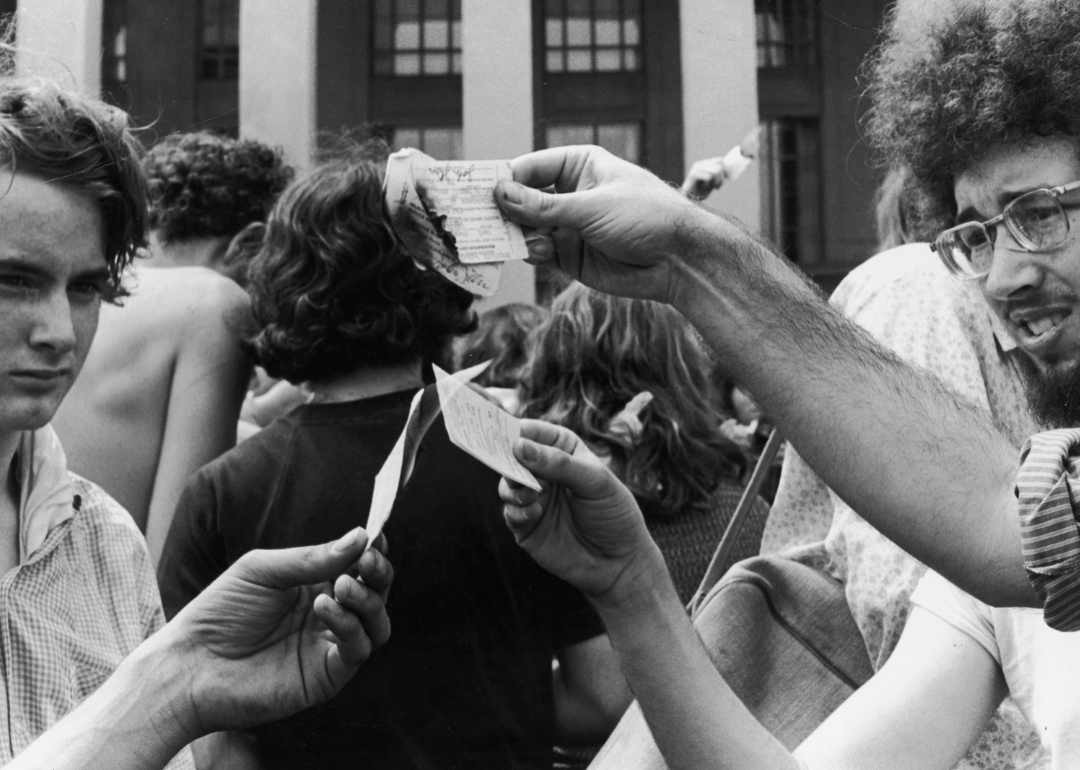
Hulton Archive // Getty Images
Burning draft cards
Anti-war demonstrators burn their draft cards.
A group of anti-war protestors burned their draft cards in 1972. Though the form of protest was seen as more symbolic than, say, fleeing the country to live in Canada, it was still illegal as determined by the Draft Card Mutilation Act of 1965.
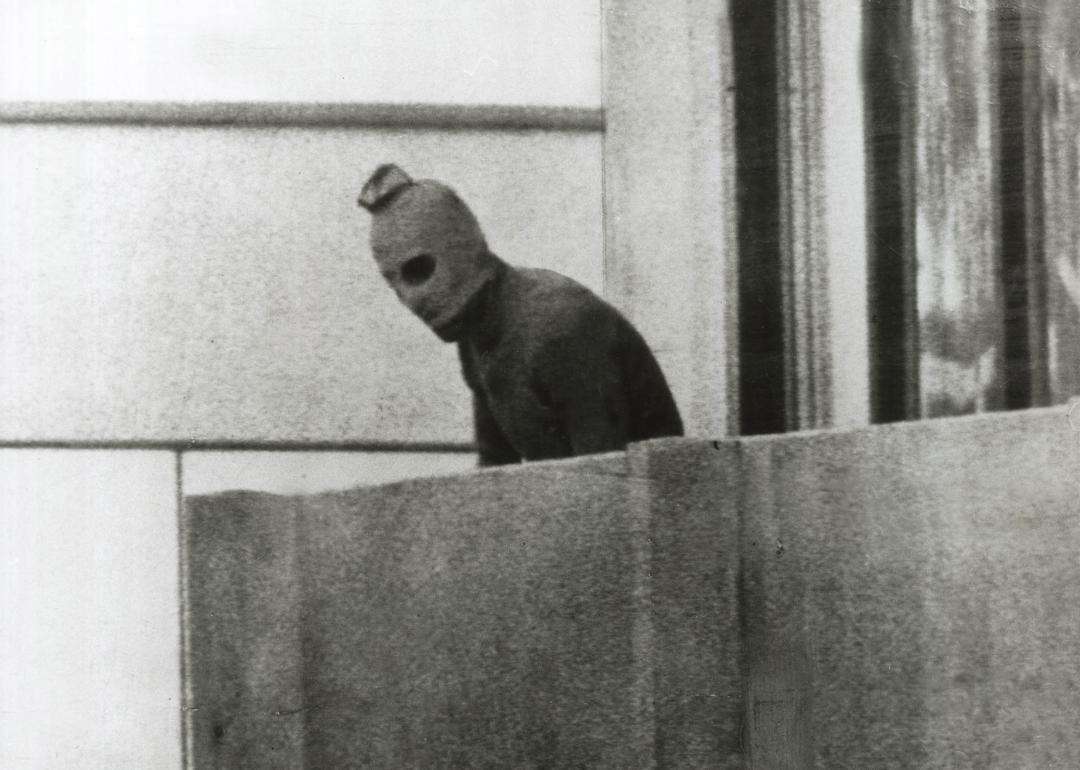
Russell Mcphedran/The Sydney Morning Herald/Fairfax Media via Getty Images
The Munich Olympic massacre
Munich Olympics hostage crisis.
In what would become one of the defining images of the 1972 Munich Olympics, a member of the Black September terrorist group stands on the balcony of the Israeli wrestling team’s dormitory. The Palestinian terrorists, calling for the release of prisoners being held in Israeli jails, took nine members of the country’s Olympic team hostage. After 20 hours, five of the terrorists, 11 Israelis, and one West German police officer would be dead.

Heritage Space // Heritage Images via Getty Images
‘Blue Marble’
View of earth from space taken by Apollo 17 astronauts.
On Christmas Eve 1972, astronauts aboard the Apollo 17 took this iconic photo of Earth, later dubbed “Blue Marble.” The incredibly detailed image would become a component of the official Earth Day flag.
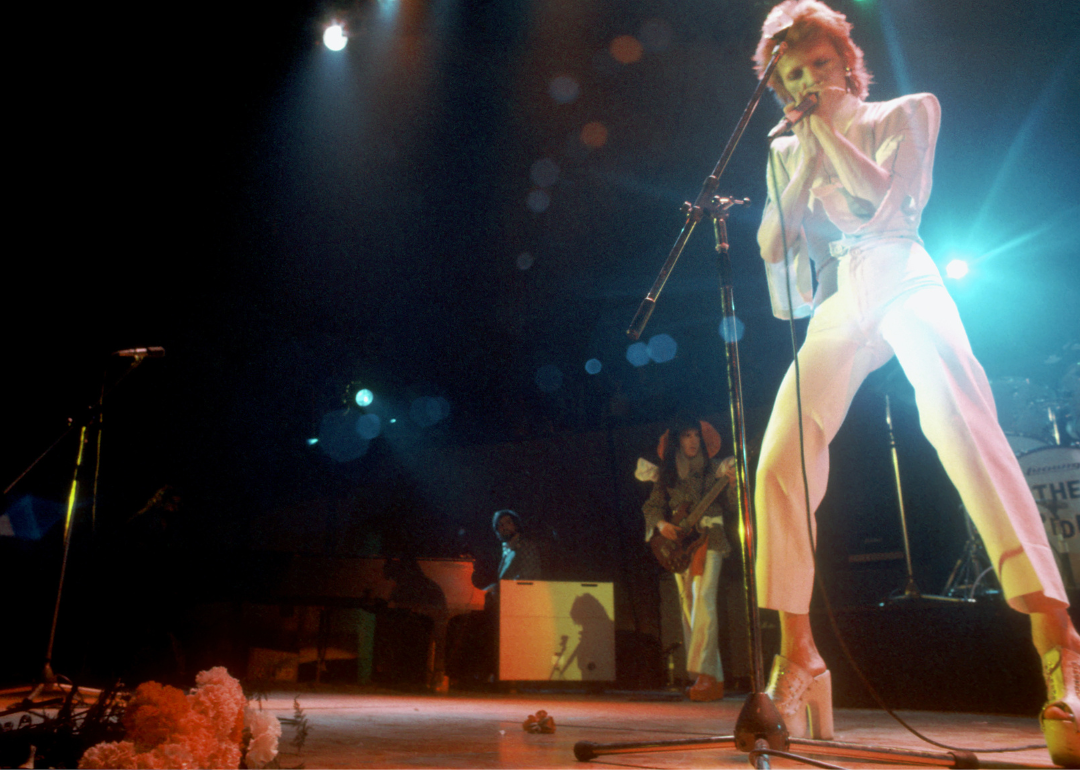
Michael Ochs Archives // Getty Images
Ziggy Stardust
David Bowie performs on stage.
David Bowie’s alter ego, alien rock star Ziggy Stardust, changed the direction of the music industry. The character, who Bowie only performed as in 1972 and 1973, practically invented the glam rock genre, and his songs had huge influences on the melodies and beats used in pop music.
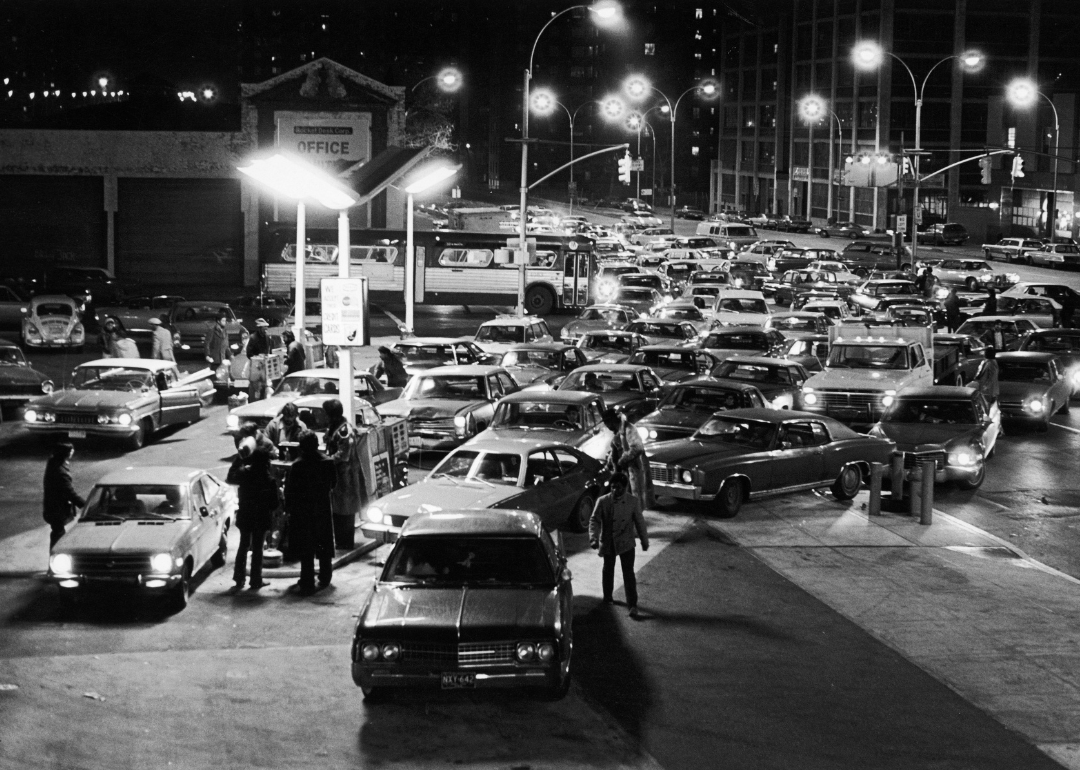
Allan Tannenbaum // Getty Images
The 1973 oil crisis
Large crowd of cars lined up for gas at night.
When member countries of the Organization of Arab Petroleum Exporting Countries placed an oil embargo against nations that supported Israel during the Yom Kippur War, bedlam ensued. Gas was difficult to come by and often rationed, and drivers would occasionally be forced to wait in extraordinarily long lines just to fill their tanks. By the end of the OAPEC embargo, gas prices had risen nearly 400% and have never fully gone back down.
You may also like: New words that were born in the ’80s

Bettmann // Getty Images
The Watergate scandal
Bob Woodward and Carl Bernstein at their Washington Post desk.
Hands down the biggest political story in 1970s America was the Watergate scandal. Here, the two journalists who broke the story, Bob Woodward (left) and Carl Bernstein, pose at their Washington Post desks.

PL Gould/Images // Getty Images
McDonald’s takes Japan
People stand at the entrance to McDonald’s restaurant in Japan.
The 1970s saw the beginnings of a globalized economy and culture. In 1971, for example, the first McDonald’s opened in Japan. While many folks saw moves like this as a way to create more wealth and opportunity, others worried the expansion of American brands endangered local cultures.
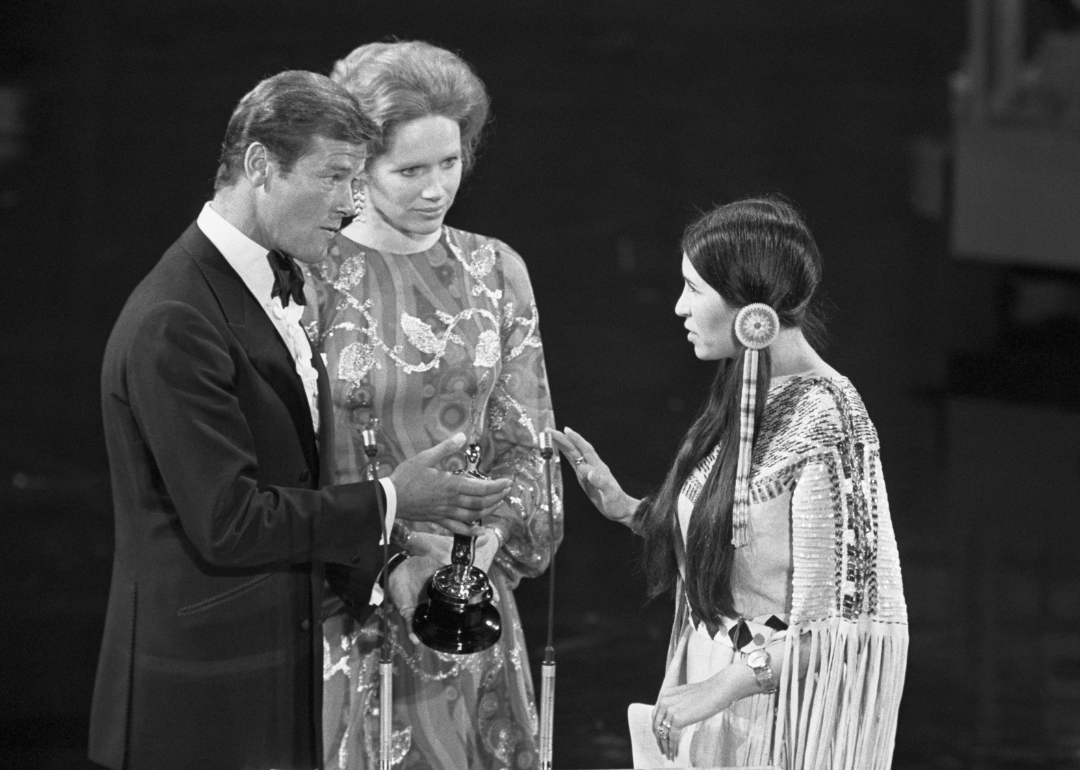
Bettmann // Getty Images
Sacheen Littlefeather attends the Oscars
Sacheen Littlefeather on stage at Academy Award ceremony.
In 1973, Sacheen Littlefeather made history when she became the first Native American to stand on stage at the Academy Awards. The actress and activist was there to refuse an Oscar on behalf of Marlon Brando, who had won Best Actor for his role in “The Godfather” and was boycotting the ceremony over Hollywood’s treatment and portrayal of Native Americans. The traditionally dressed Littlefeather was booed off stage by unimpressed attendees.
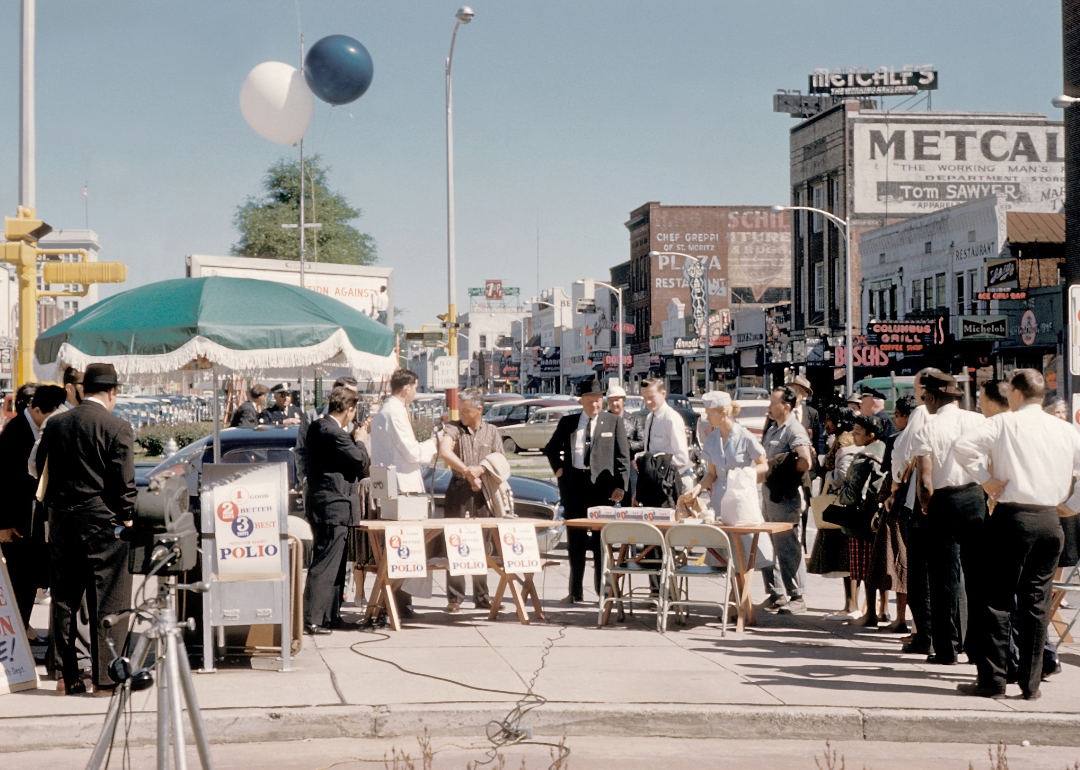
CDC/Charles N. Farmer/Smith Collection/Gado // Getty Images
Polio vaccinations
People receive polio vaccine in Columbus, Georgia.
Residents of Columbus, Georgia, lined up to receive polio vaccinations in 1973. Thanks to the efforts of the National Polio Immunization Program, polio cases across the country dropped from 20,000 per year in the 1950s to just 10 per year by 1979.
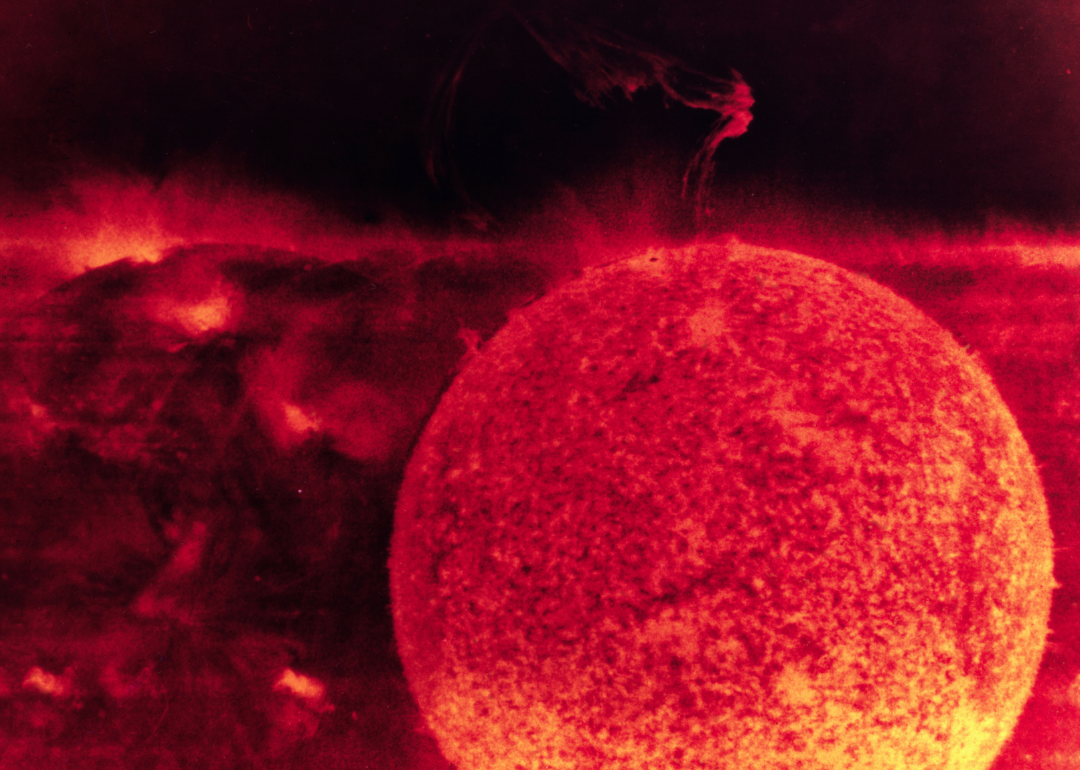
Bettmann // Getty Images
Skylab 3
Close-up image of sun’s surface.
The Skylab 3 crew set a record in 1973 when it spent a whopping 59 days and 11 hours in space. The three astronauts flew to Skylab, the first American space station, where they conducted experiments and took photos, including this one of a pocket of helium gas erupting from the sun.
You may also like: One-hit wonders of the 1960s
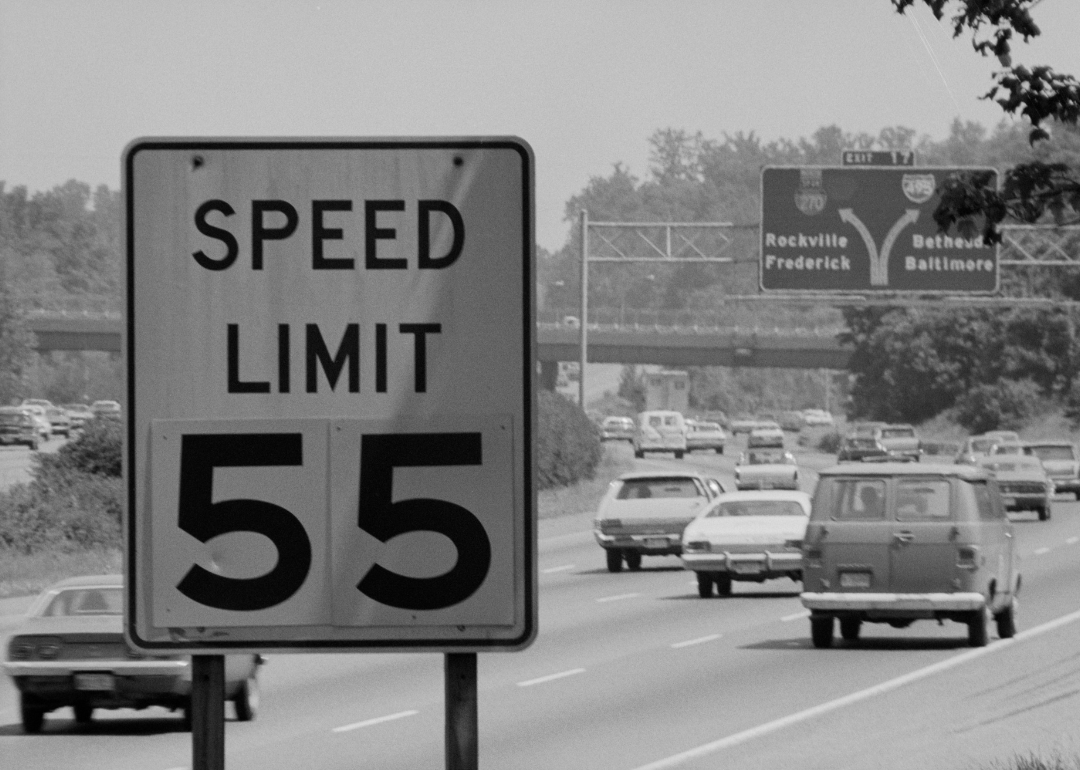
US News & World Report Collection/PhotoQuest // Getty Images
National speed limit laws enacted
“Speed Limit 55” sign beside Washington DC beltway.
In the early weeks of 1974, President Richard Nixon signed a bill into law that lowered the national highway speed limit to 55 miles per hour. The idea was that slower speeds would help save gas and diesel, which, in turn, would take pressure off the ongoing oil shortage. President Bill Clinton repealed the law in 1995, allowing states to set their own speed limits.
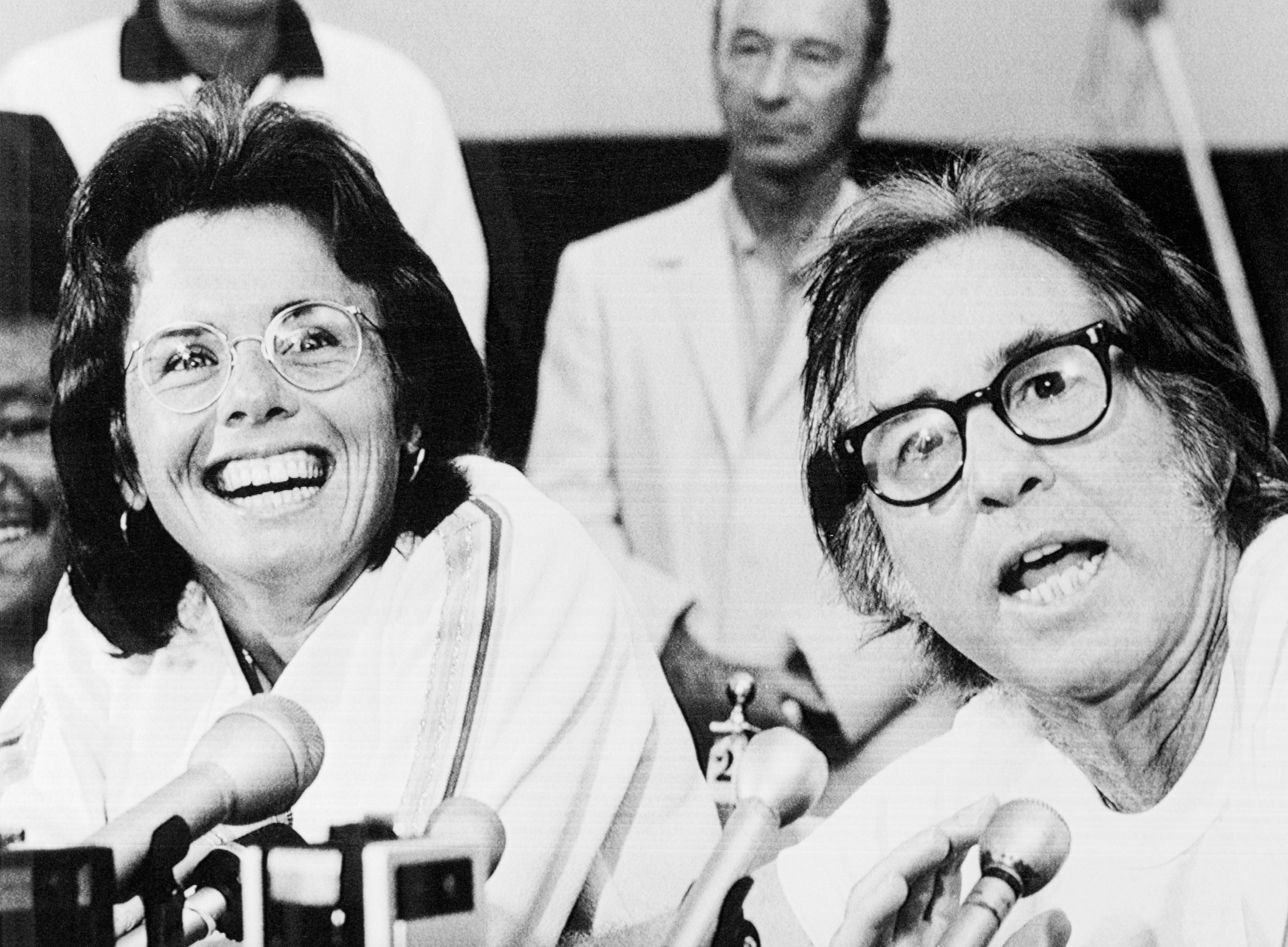
Bettmann // Getty Images
King defeats Riggs
Bobby Riggs and Billie Jean King pose for the press before tennis match.
In 1973, 90 million people tuned in to the Battle of the Sexes tennis match. A 29-year-old Billie Jean King handily defeated 55-year-old Bobby Riggs, who had previously gone on record saying that women’s tennis was so inferior to men’s tennis that even an older player like him could beat the best women’s players. Talk about eating your words.
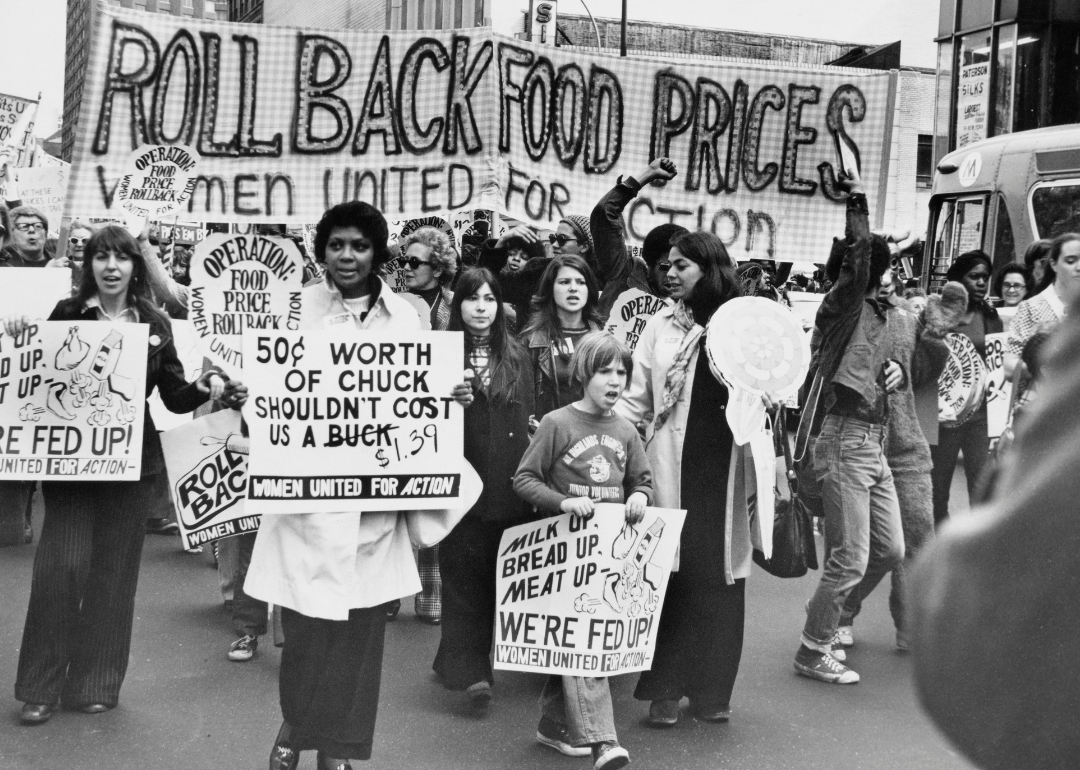
Keystone/Hulton Archive // Getty Images
Skyrocketing inflation
Women and children marching to protest the rise of food prices.
Due to numerous compounding economic factors, the 1970s brought about some of the highest inflation rates in recent history. The purchasing power of a dollar hit a near all-time low, making prices of things like groceries skyrocket. Here, women and children march in New York City, protesting the rising costs of things like milk, bread, and meat.
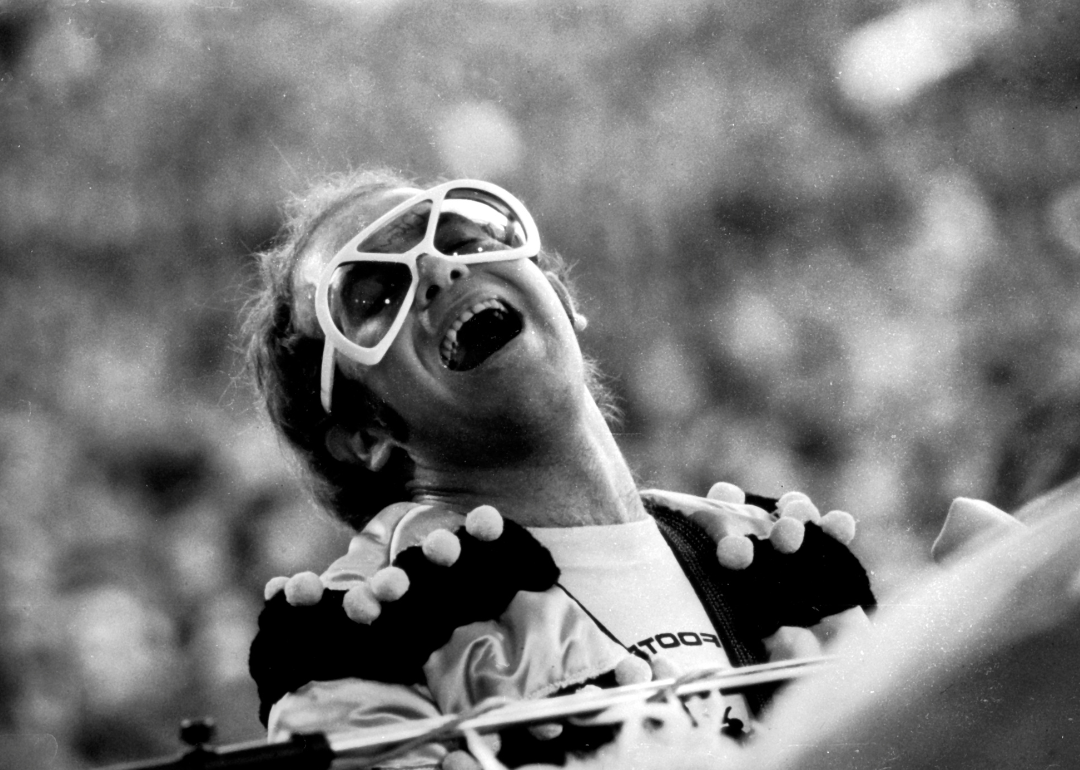
Anwar Hussein // Getty Images
Elton John entertains the world
Elton John performs on stage.
Elton John was one of the busiest artists of the 1970s. Here, he performs at an outdoor concert in England during one of his eight tours that took place between 1970 and 1974.
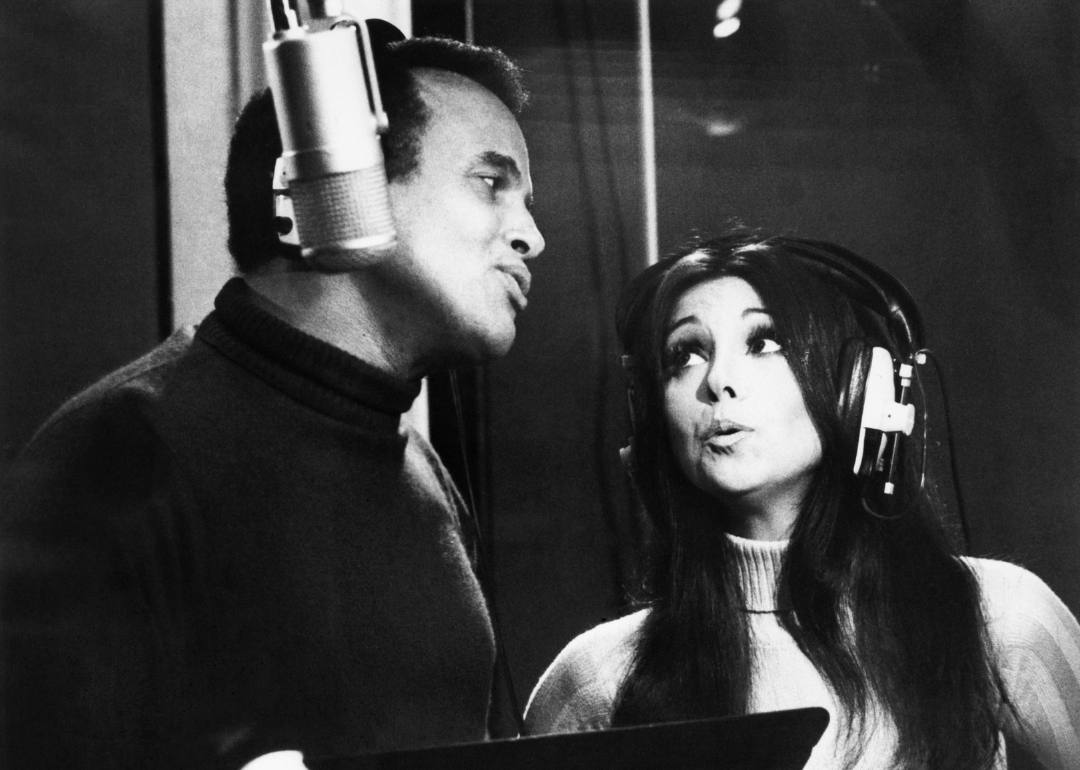
Bettmann // Getty Images
‘Free to Be… You and Me’
Harry Belafonte and Marlo Thomas sing into microphone.
In the early ’70s, actress Marlo Thomas collected several of her celebrity friends, including folks like Cicely Tyson, Michael Jackson, Shel Silverstein, Mel Brooks, and Alan Alda, to help her put together a children’s book and a record that challenged traditional gender norms. The project, “Free to Be… You and Me,” also garnered its own television special that challenged the sexist beliefs which had long been ingrained in our culture.
You may also like: What life was like in the Roaring Twenties
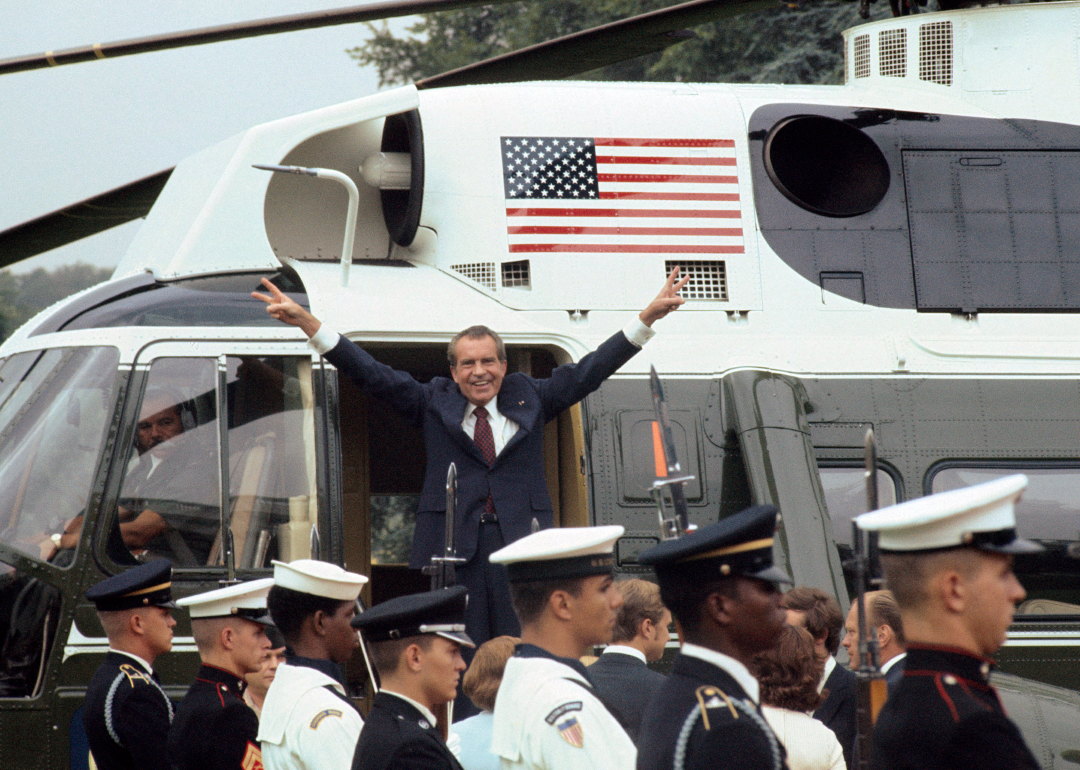
Bettmann // Getty Images
President Nixon resigns
Richard Nixon in helicopter giving “V” sign after resignation.
On Aug. 8, 1974, Richard Nixon made a televised appearance in which he resigned from the presidency following the Watergate scandal. He told the people: “I have never been a quitter. To leave office before my term is completed is abhorrent to every instinct in my body. But as president, I must put the interest of America first.” The following day, he boarded Air Force One, leaving the White House for the last time. He remains the only president in history to resign from office.

Fotos International // Getty Images
Jane Goodall gets to work
Jane Goodall sitting with African baboon.
Jane Goodall, now the world’s foremost expert on chimpanzees, was still early into her tenure at Tanzania’s Gombe Stream National Park in the 1970s. Later in the decade, the primatologist opened the Jane Goodall Institute, a wildlife and environmental conservation organization.
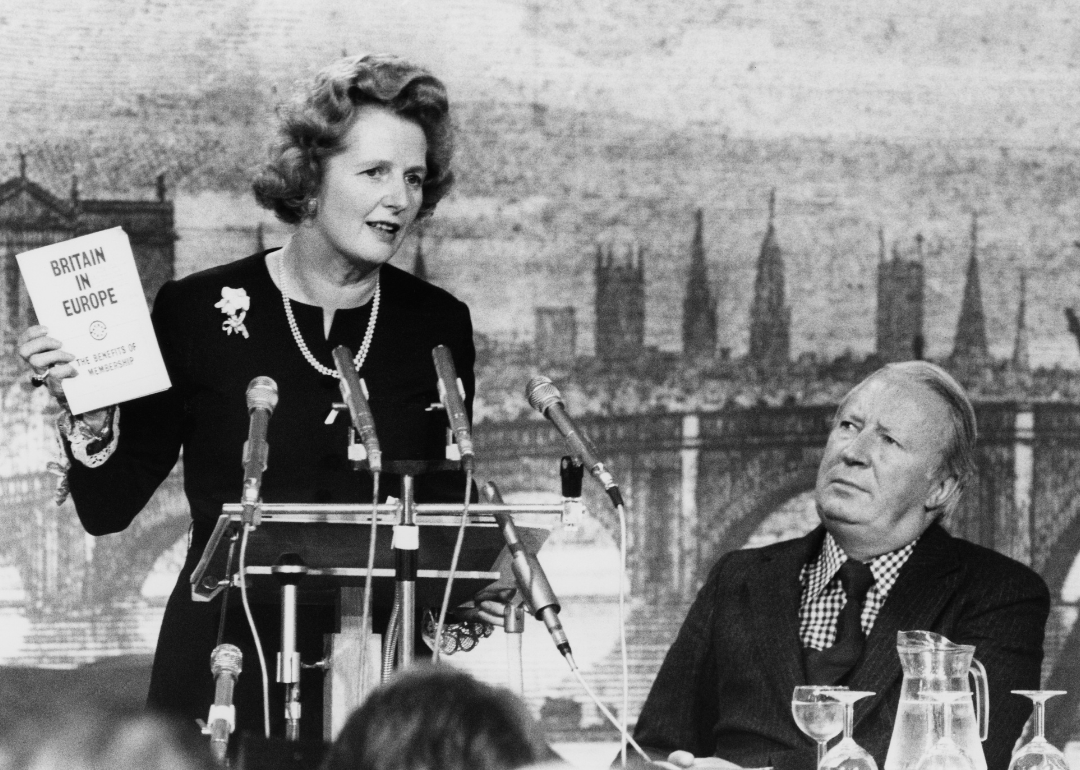
Central Press/Hulton Archive/Getty Images
Margaret Thatcher wins office
Margaret Thatcher speaks speaking at Conservative Party meeting.
Britain’s first woman prime minister, Conservative Margaret Thatcher, won against Edward Heath for Opposition Party leadership and won in 1975. She became prime minister in 1979. Dubbed the Iron Lady, she was known for her uncompromising leadership style and hardline politics.
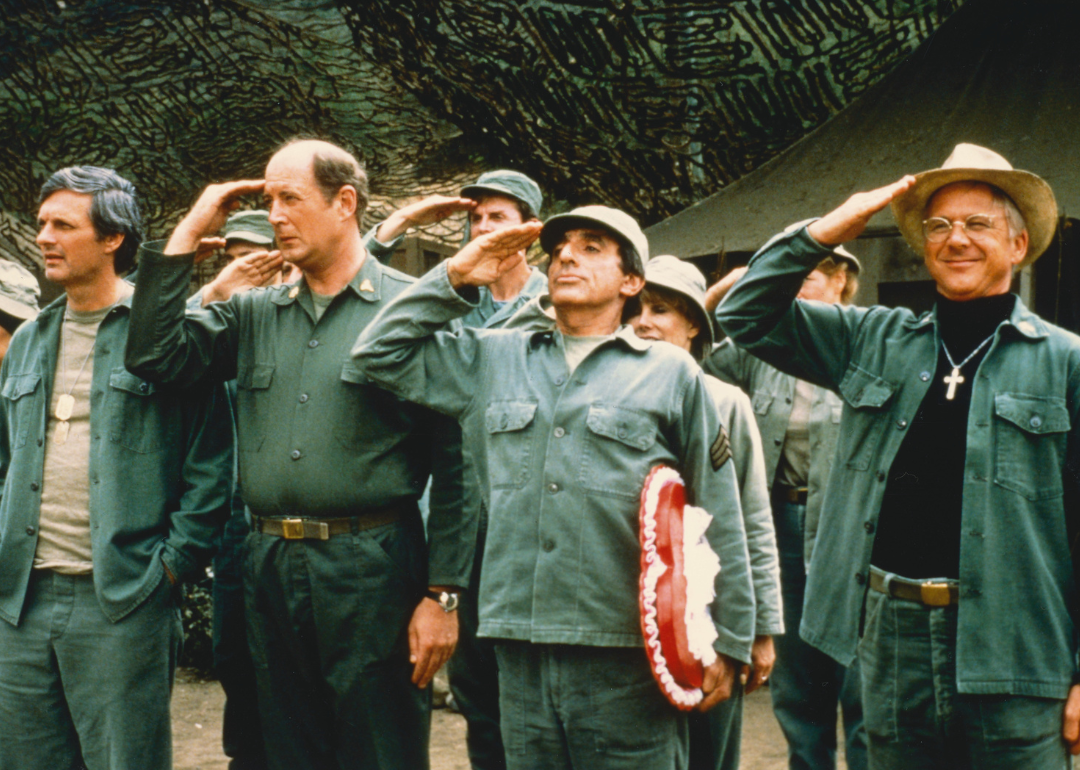
Silver Screen Collection // Getty Images
‘MASH’
Publicity still from the television series ‘MASH.’
“MASH,” a series that followed the staff of an Army hospital during the Korean War, hit the airwaves in 1972. Hugely popular, the dramedy was nominated for more than 100 Emmy Awards over the course of its 11-season run, and its finale remains the most-watched finale of any TV show.
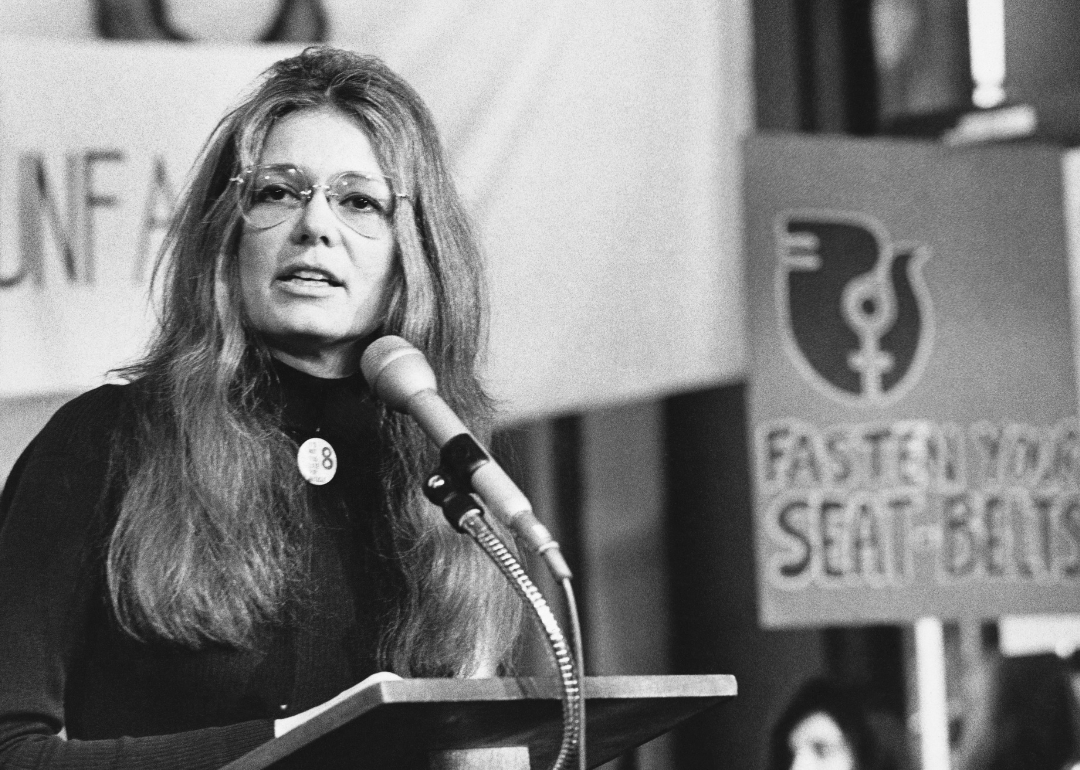
Bettye Lane/Photo Researchers History // Getty Images
Gloria Steinem speaks out
Gloria Steinem speaks at a rally.
Famed journalist, activist, and feminist leader, Gloria Steinem became a leading voice in the fight for women’s liberation during the 1970s. During this decade, she founded the National Women’s Political Caucus and the Women’s Action Alliance.
You may also like: Popular child stars from the year you were born
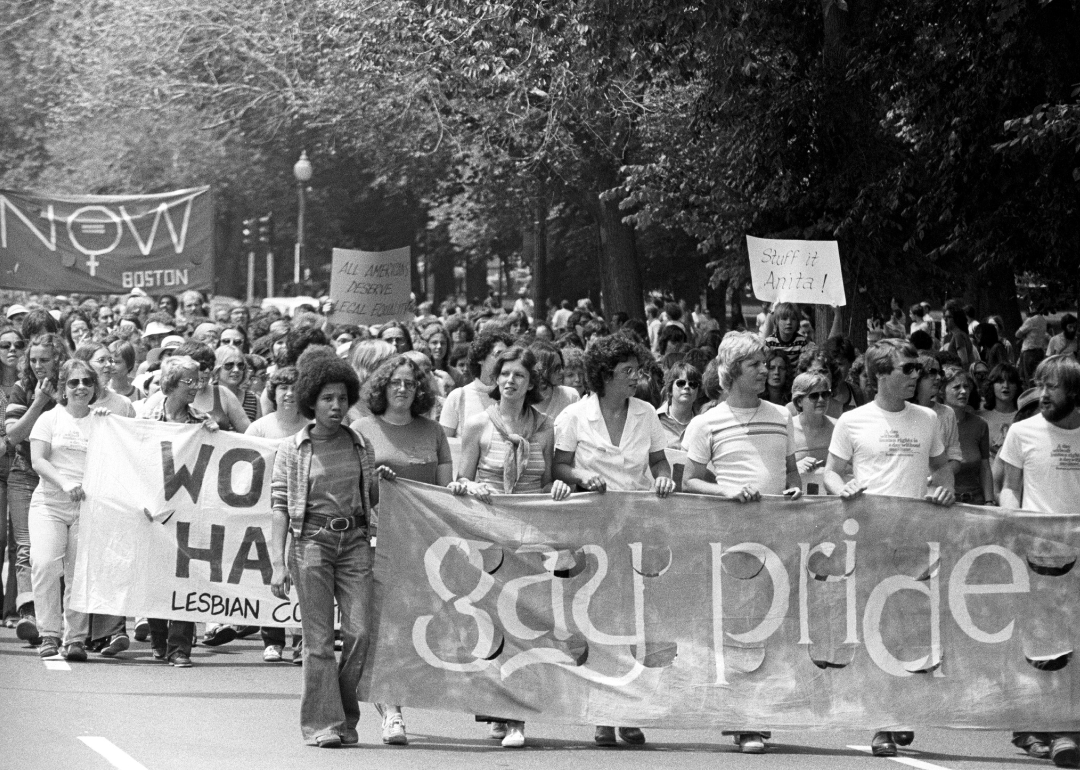
Spencer Grant // Getty Images
Marching for equality
People walking in pride parade.
Following the Stonewall riots of 1969, the lesbian and gay men movement gained traction in the United States during the 1970s. Marches like this one in Boston’s Back Bay neighborhood became frequent occurrences, increasing the visibility of and demanding equality for the formerly ostracized group.
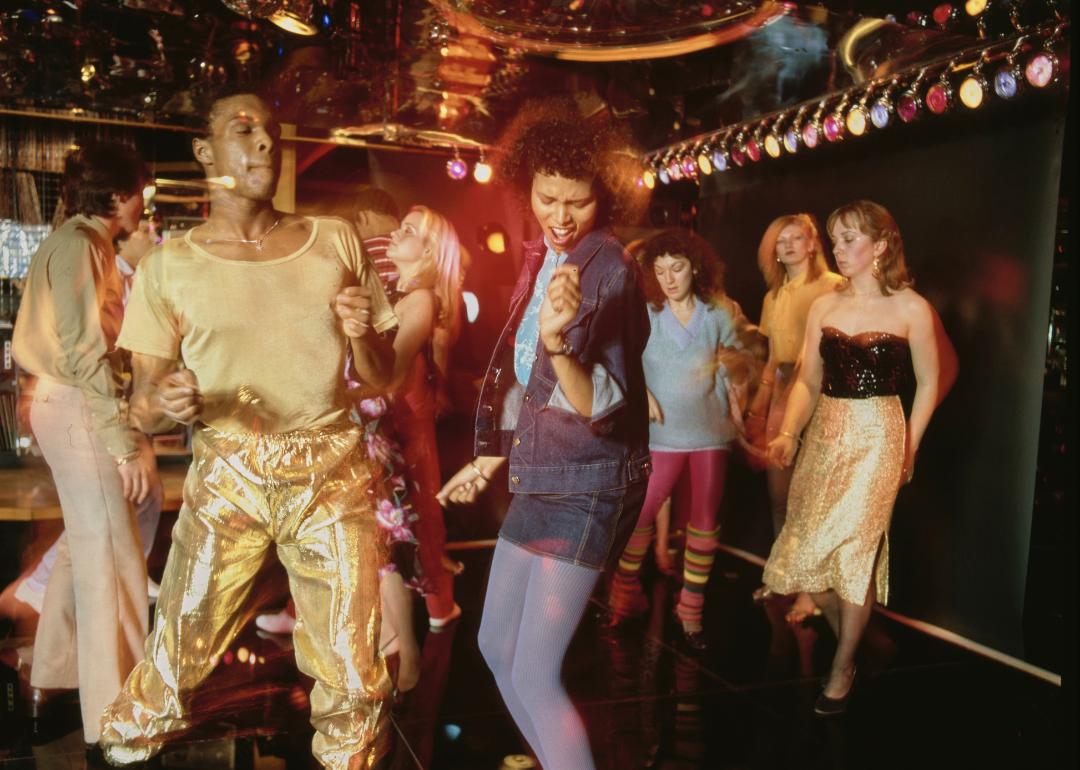
David Redfern/Redfern’s // Getty Images
Disco dancin’
People dancing at discotheque.
The disco scene blipped in and out of popularity in the 1970s. Born in New York City, the movement provided a sense of liberation and freedom for the average American, and disco clubs provided a safe place where folks from all walks of life could gather to let loose.
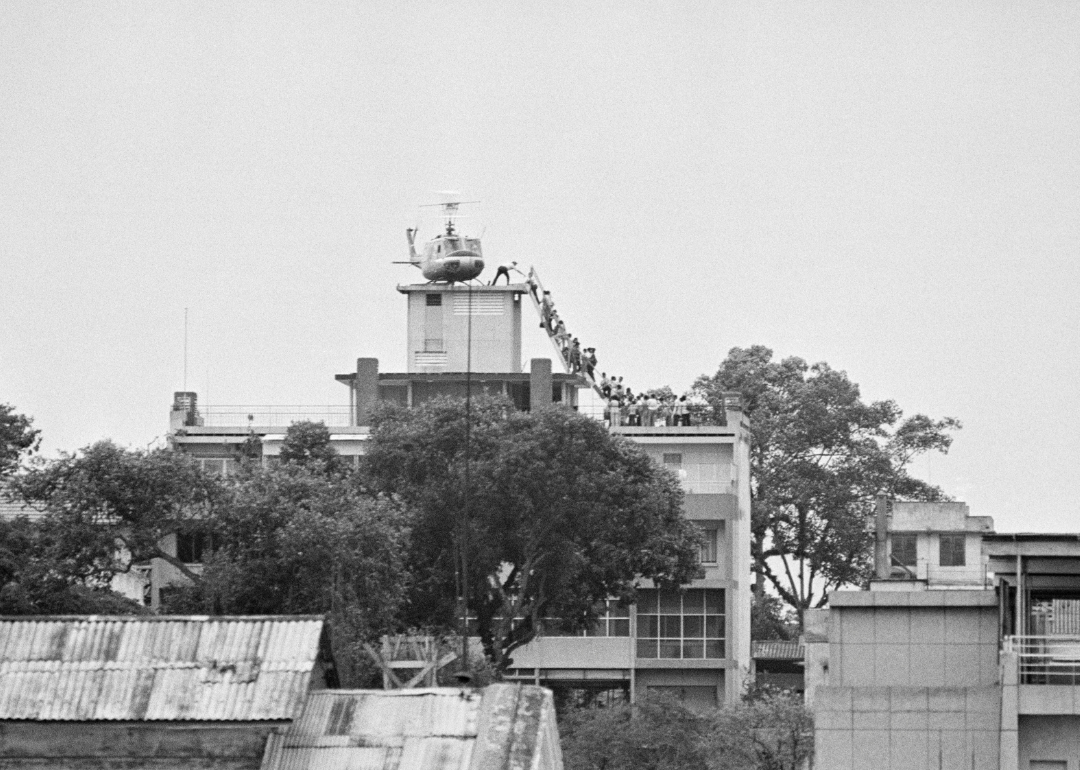
Bettmann // Getty Images
The fall of Saigon
Helicopter evacuation of Vietnamese from rooftop in Saigon.
The Vietnam War came to a stunning and final end in 1975 when Saigon fell to communist Northern Vietnamese forces. Here, the CIA helps a stream of Vietnamese evacuees flee via helicopter.
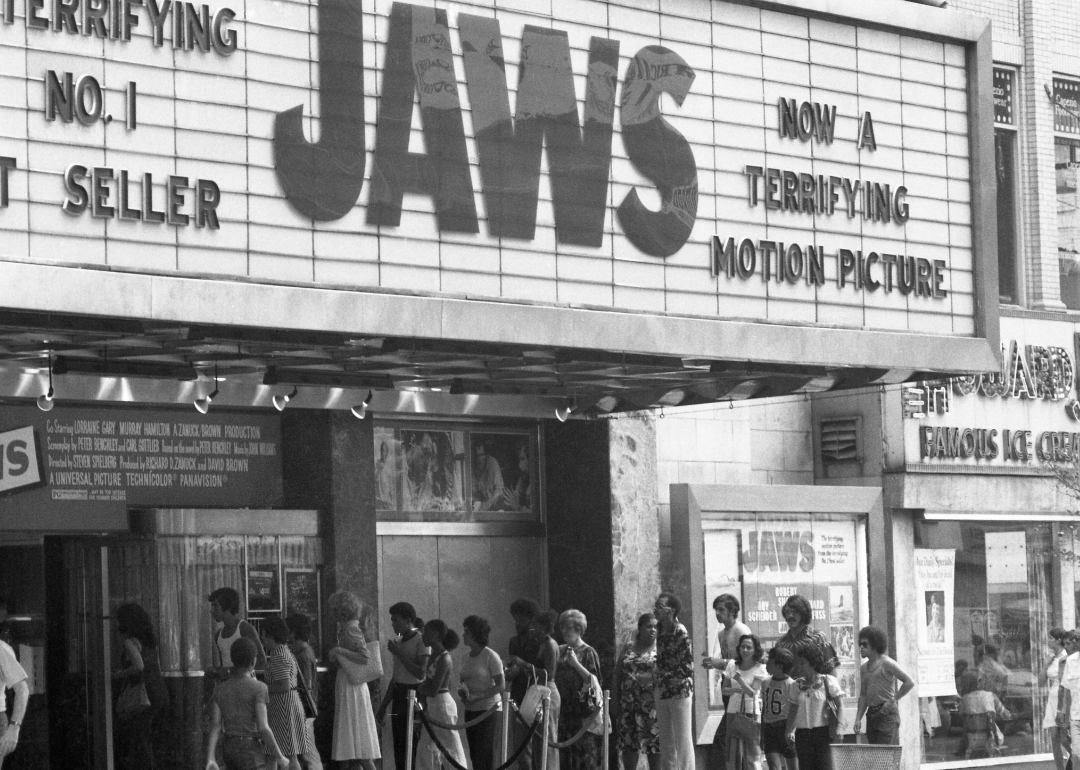
Bettmann Archive // Getty Images
‘Jaws’ premieres
Crowds in line under movie marquee featuring ‘Jaws.’
Steven Speilberg’s shark thriller “Jaws” premiered in 1975. The first summer blockbuster, the movie was also the highest-grossing film of all time when it was released, bringing in more than $100 million at the box office.
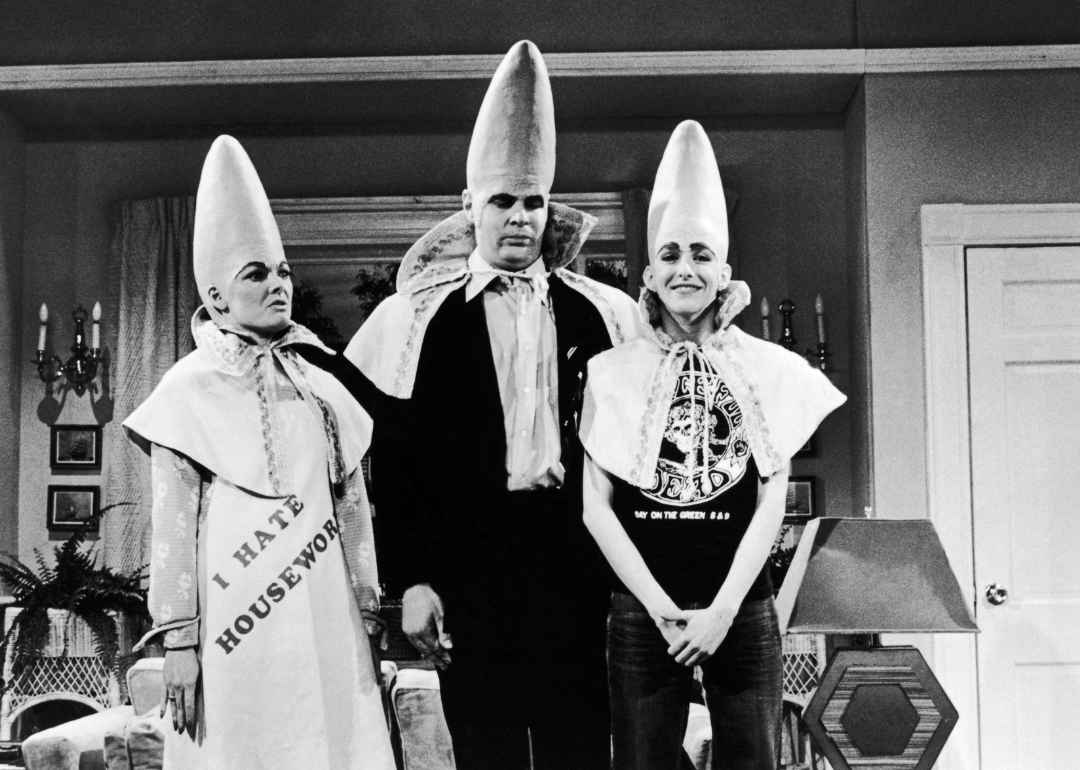
Warner Bros. // Getty Images
Live from New York…
Jane Curtin, Dan Aykroyd, and Laraine Newman in ‘Saturday Night Live’ skit.
…it’s Saturday Night!
The classic sketch comedy show “Saturday Night Live” debuted in 1975. Although audiences’ attitudes toward it were lukewarm initially, the series quickly found its footing. Around 4 million people still tune in each week to catch its incisive takes on politics and pop culture.
You may also like: What “cool beans” and 50 other old-timey slang words mean
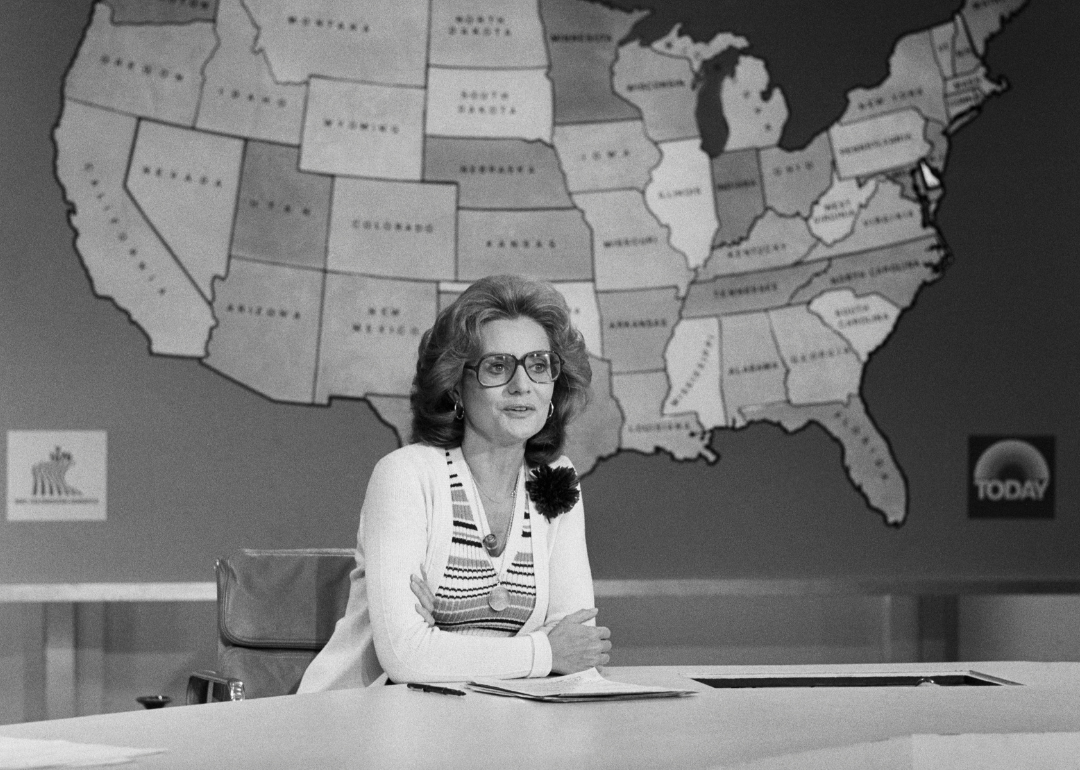
Bettmann // Getty Images
Barbara Walters breaks glass ceilings
Barbara Walters speaks to her audience on ‘The Today Show’.
In the 1970s, pioneering TV journalist Barbara Walters became the first woman to be named an official co-host of the “Today” show and the first woman to co-anchor an evening news program. Here, she announces to viewers that she’ll be leaving NBC for ABC, where she’d be hosting the evening news alongside Harry Reasoner, earning $5 million over five years.
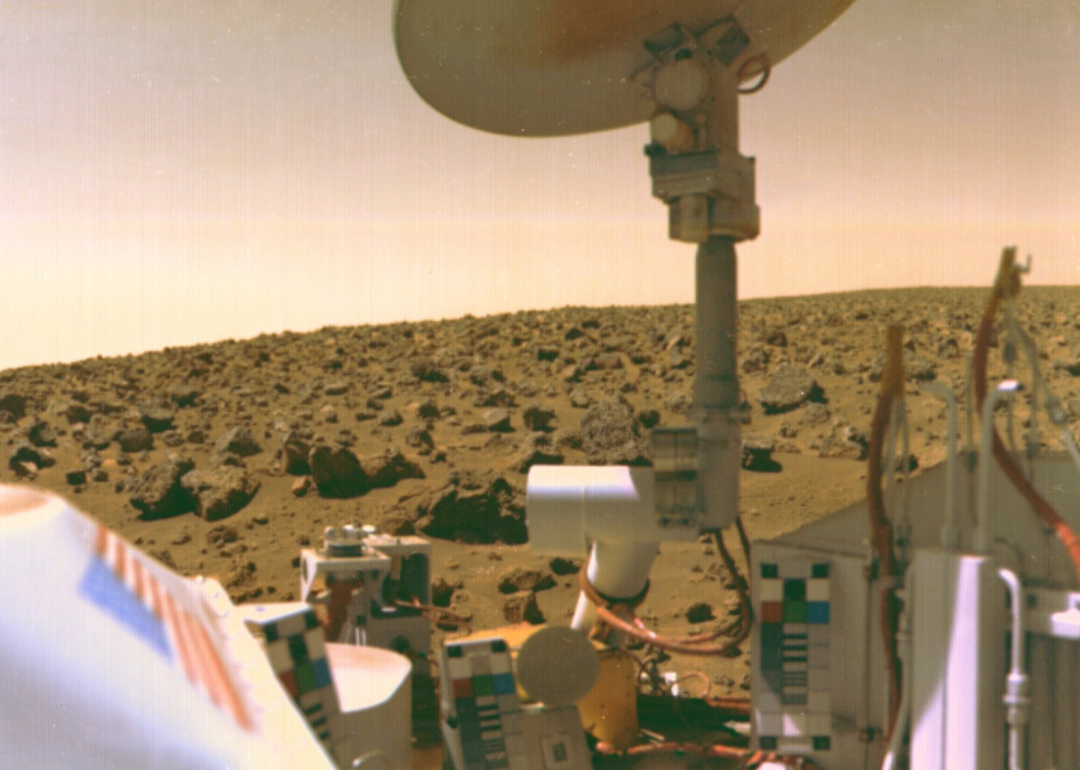
Heritage Space/Heritage Images via Getty Images
A journey to Mars
Images from Mars.
The first long-term missions to Mars began in the mid-’70s when two pairs of orbiters and landers—Viking 1 and Viking 2—touched down on and orbited the Red Planet. For years, the spacecraft crawled across the surface of the planet and circled it at the same time, sending pictures like this one back to scientists at NASA.
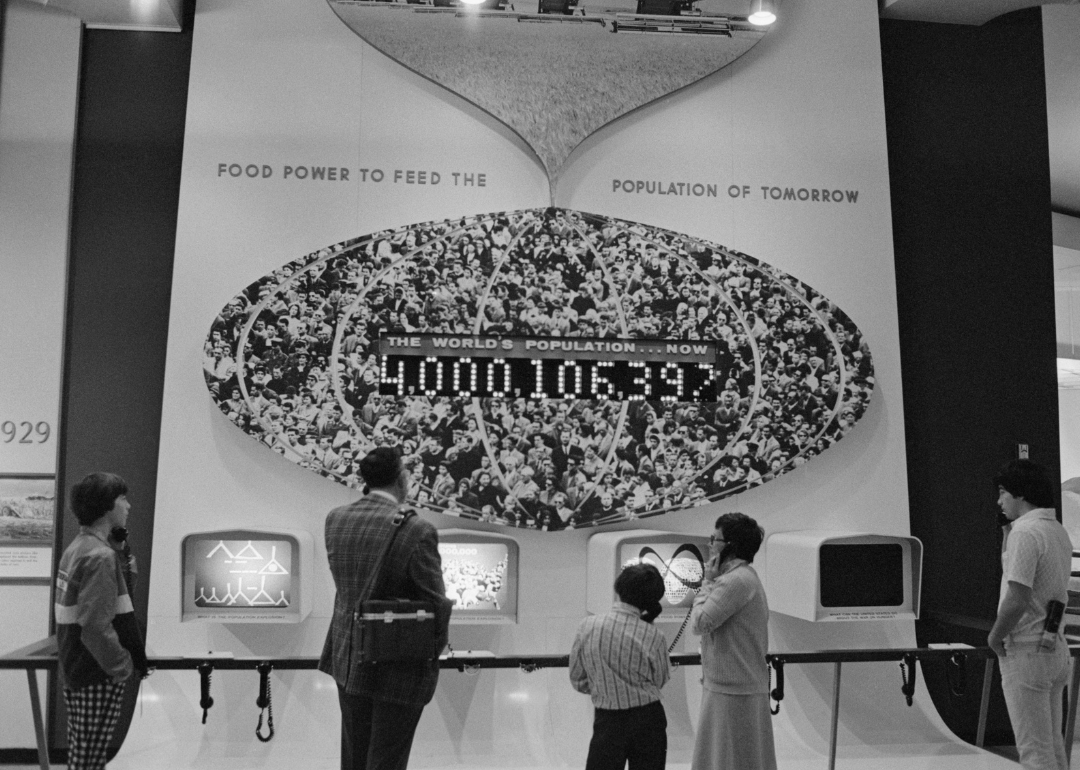
Bettmann // Getty Images
World population hits 4 billion
Visitors to Chicago’s Museum of Science and Industry look at world population clock.
In 1974, the world population officially hit 4 billion. Some 50 years later, the population has nearly doubled, hitting 8 billion at the end of 2022.
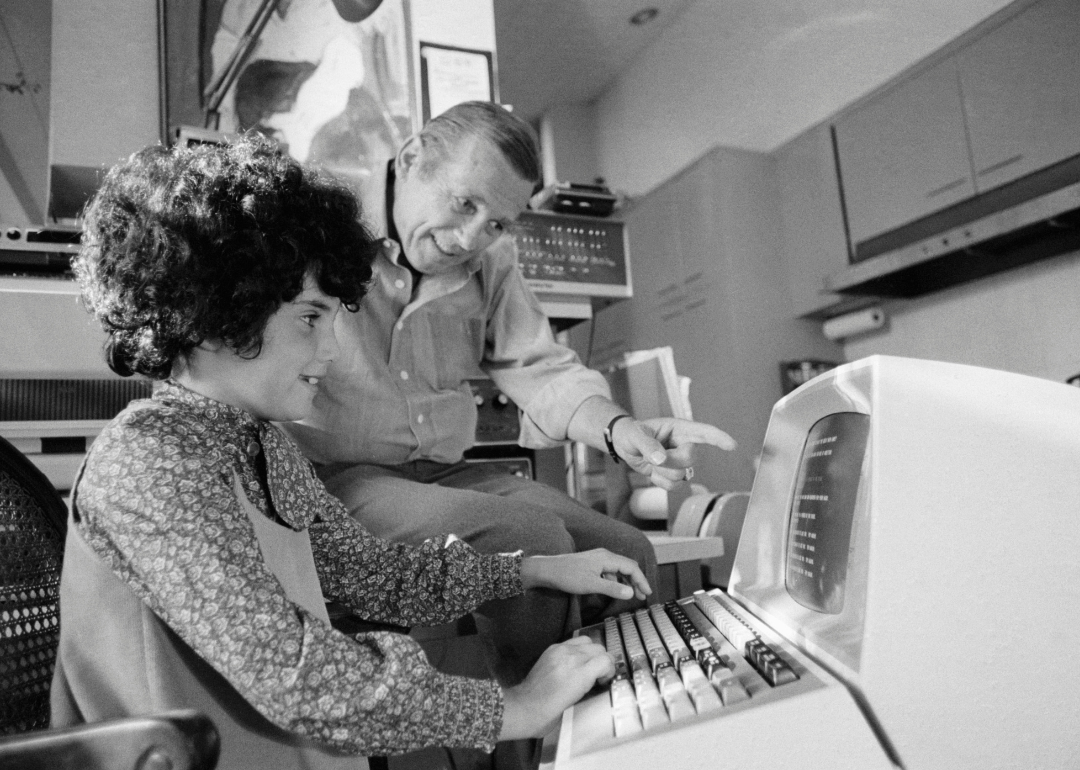
Tony Korody/Sygma/Sygma via Getty Images
The birth of the personal computer
Child reaches for keyboard on personal computer.
The first personal computers began making their way into homes in the early 1970s. Machines like the Kenbak-1, the Wang 2200, and the Xerox PARC Alto were among the first mass-market options available to consumers with money to burn.
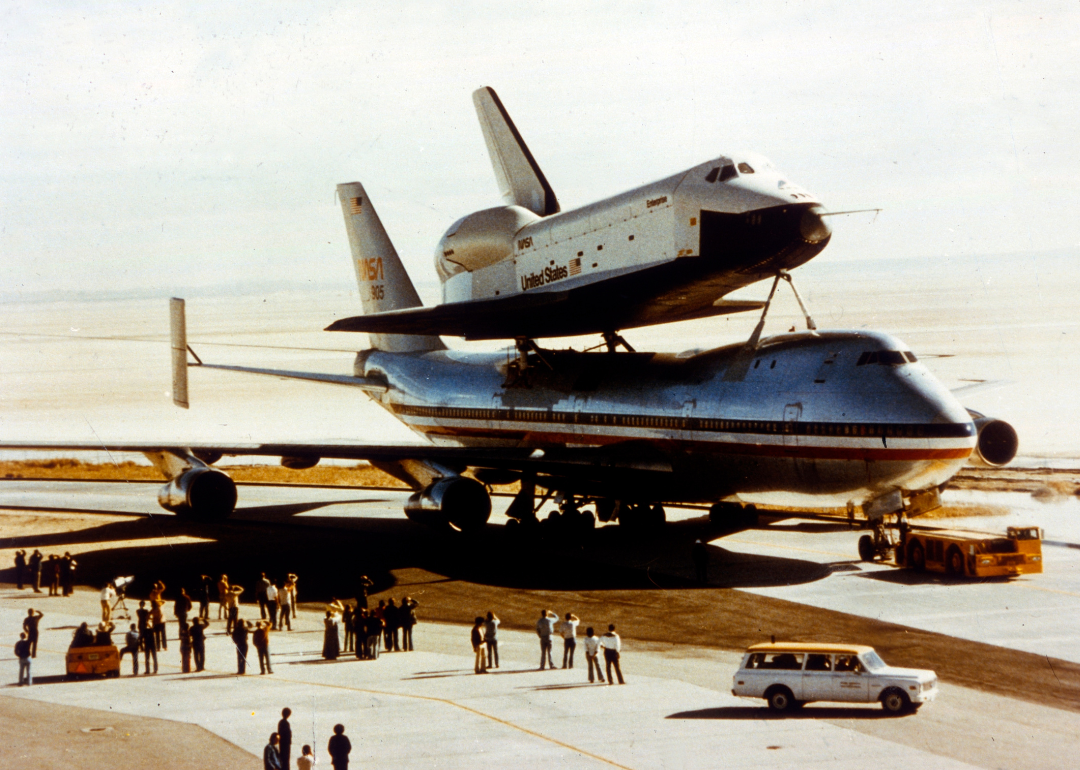
Heritage Space/Heritage Images/Getty Images
The Enterprise takes flight
Space Shuttle Orbiter on Boeing 747.
The Space Shuttle Enterprise was rolled out in 1976. Not actually capable of space flight since it lacked both engines and a heat shield, the orbiter spacecraft was pivotal in the development of the eventual space shuttle program and had a huge role in the popularization of space exploration with the average American.
You may also like: 60 photos that capture summer in the ’60s
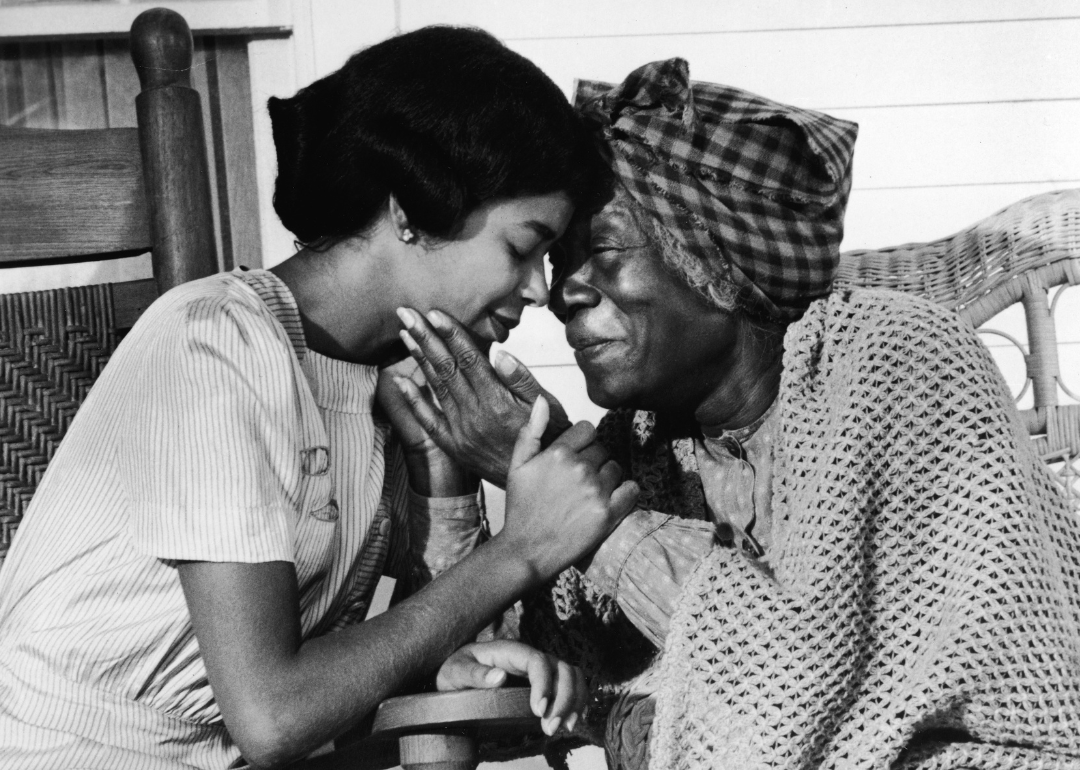
ABC Television // Getty Images
‘Roots’
Irene Cara and Beah Richards in a still from ‘Roots’.
A national phenomenon, “Roots” is a 1977 TV miniseries that tells the dramatized story of members of author Alex Haley’s family tree, from their origins in Africa through their time as enslaved people in the South. The series was actor LeVar Burton’s breakout role.
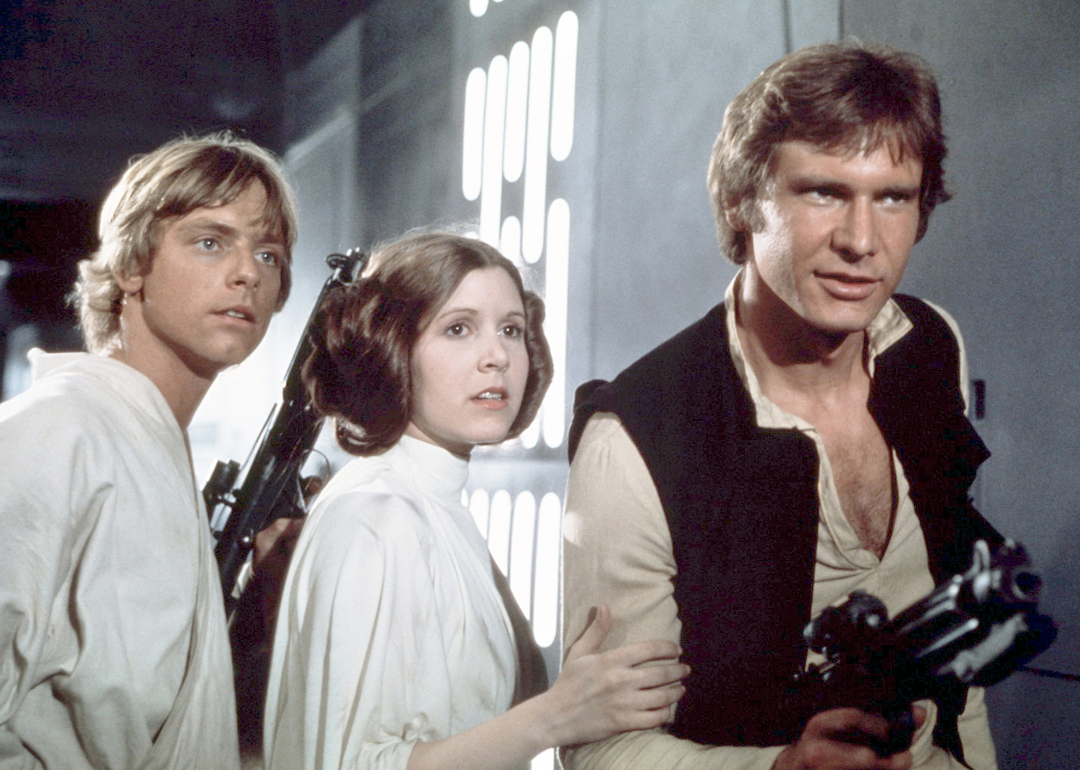
Sunset Boulevard/Corbis via Getty Images
A long time ago…
Mark Hamill, Carrie Fisher and Harrison Ford on the set of Star Wars: Episode IV – A New Hope
…in a galaxy far away.
So began George Lucas’ groundbreaking 1977 space epic “Star Wars— Episode IV: A New Hope.” An instant hit, the film remains one of the highest-grossing films of all time.
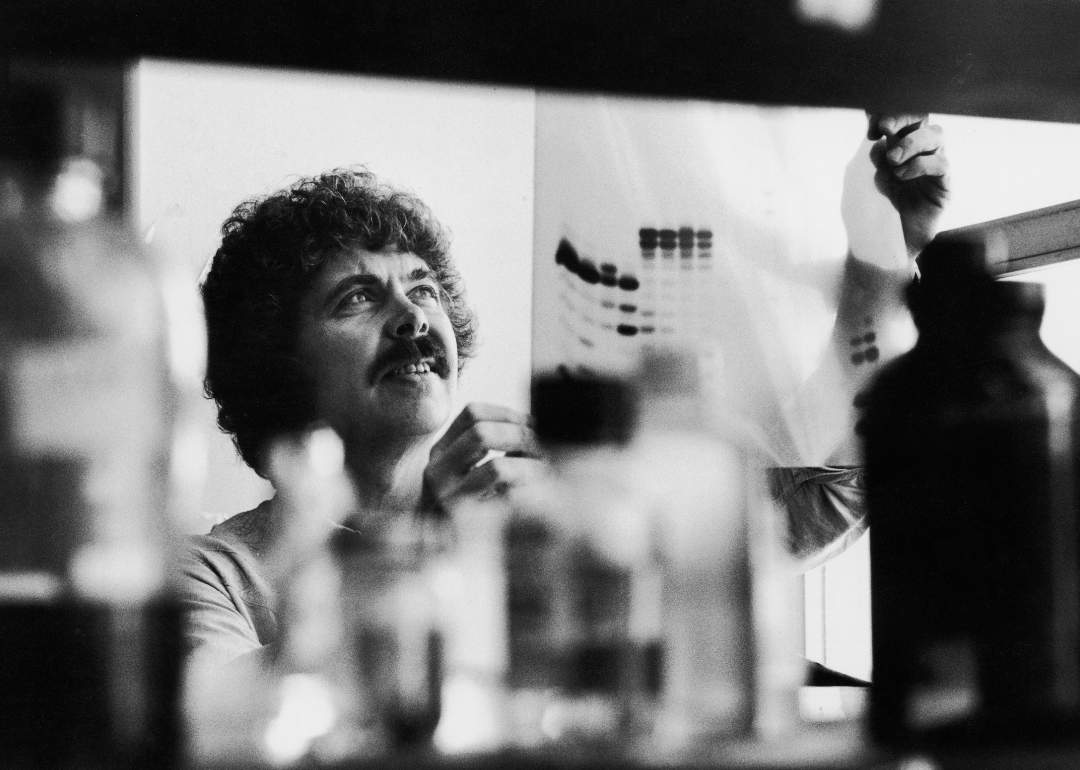
Mark Kauffman // Getty Images
The biotechnology industry begins
Dr. Herbert Boyer looking at radioautogram in laboratory.
Microbiologist Herbert Boyer, his collaborator Stanley Cohen of Stanford, and venture capitalist Robert Swanson helped create today’s biotechnology industry. In the 1970s, Boyer and Cohen became the first to clone DNA successfully and to figure out how to modify bacteria into human proteins, such as insulin and growth hormones, that could then be used for medicinal and therapeutic reasons. Together with Swanson, the duo founded Genentech, whose first product created a chemically synthesized gene for human insulin.
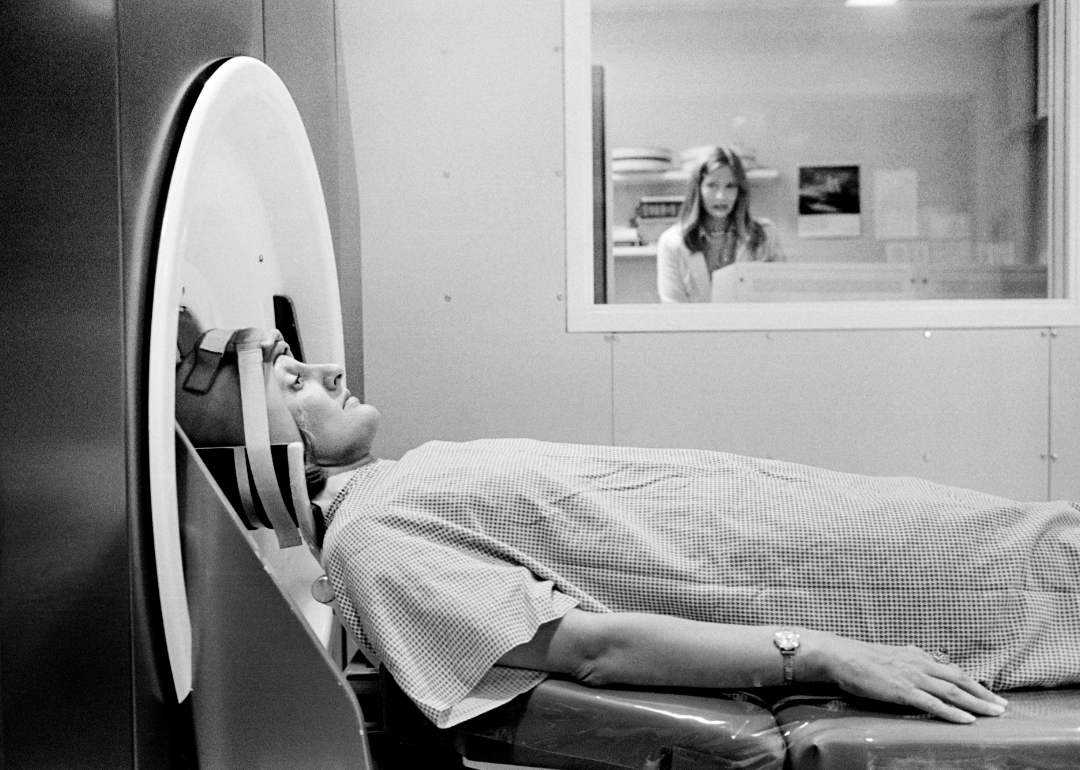
Warren K Leffler/Universal History Archive/Universal Images Group via Getty Images
A diagnostic leap forward
Patient ready to receive CAT scan in medical facility.
Godfrey Hounsfield, an eccentric British engineer, developed the first CT scanner and scanned the first patient in 1971. By 2020, the machine was being used in hospitals worldwide to take detailed images of the brain and other parts of the body.
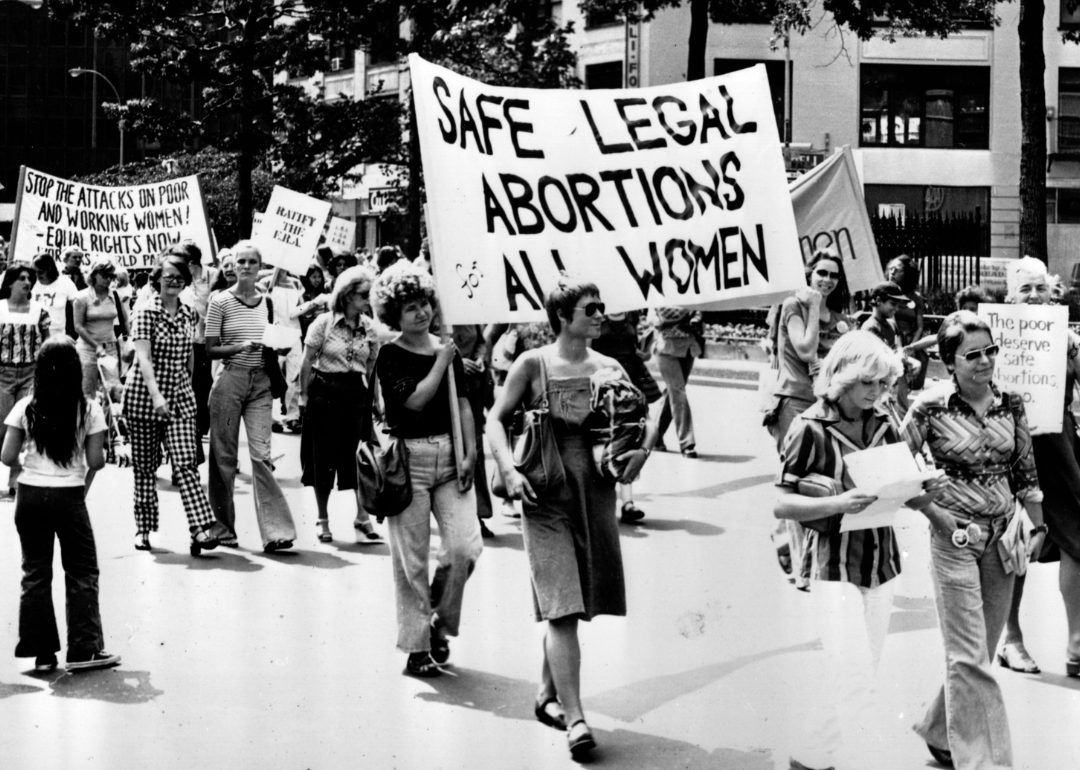
Peter Keegan/Keystone/Getty Images
Abortion rights become a hot-button issue
Women walk in a demonstration advocating “Safe legal abortions for all women”.
In contrast to what’s happening now, women were gaining rights to what they could do with their bodies in the 1970s. The Supreme Court established a woman’s right to access abortion nationally with its decision on Roe v. Wade in 1973. Despite the court’s support, abortion services were not always easily accessible or available to women from all walks of life, which led to protests around the country.
You may also like: Food history from the year you were born
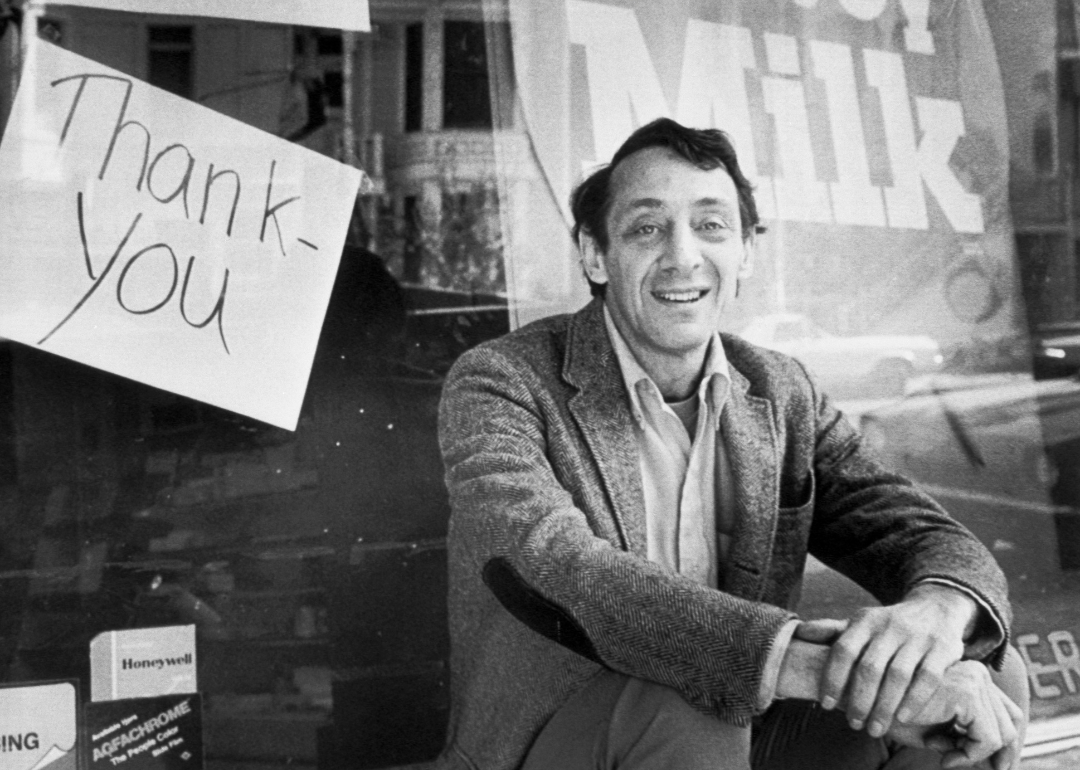
Bettmann // Getty Images
Harvey Milk
Portrait of smiling Harvey Milk outside of camera shop in San Francisco.
Harvey Milk, one of the first openly gay men elected to public office, sat on the San Francisco board of supervisors for 10 months in 1978 before he was assassinated by a fellow politician who disagreed with his politics and lifestyle choices. Here, Milk sits in front of the Bay Area camera shop he owned.
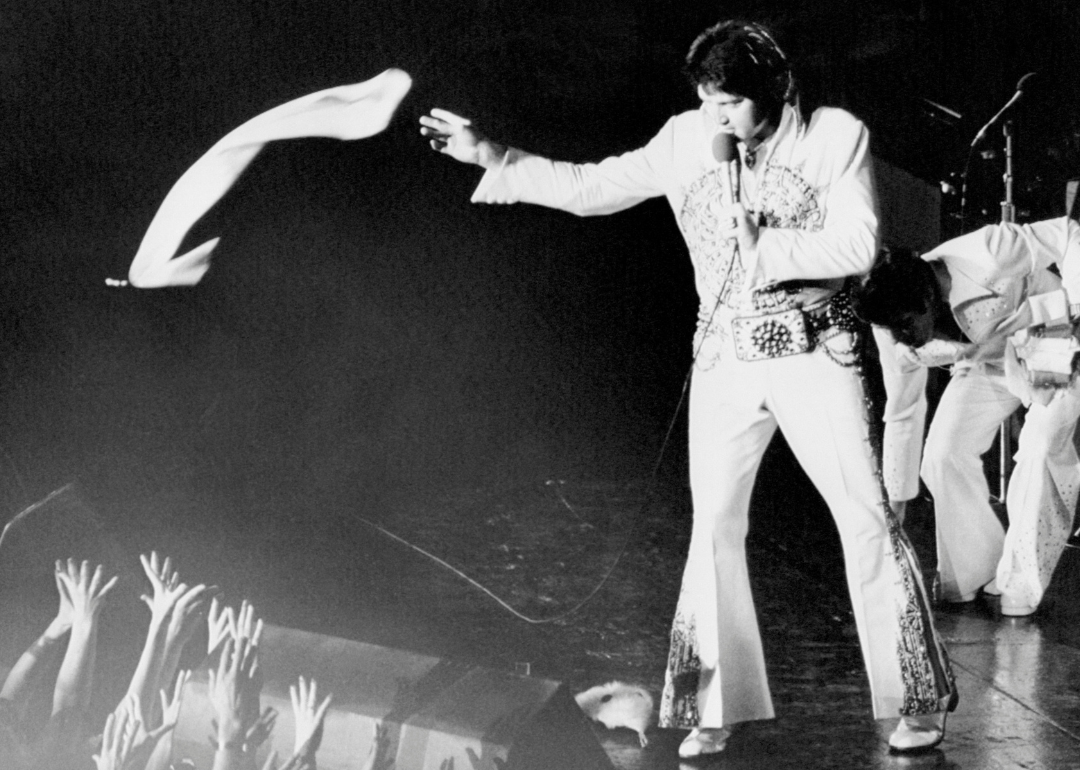
Bettmann // Getty Images
Elvis Presley dies
Elvis Presley tosses a scarf to fans during a performance.
On Aug. 16, 1977, Elvis Presley, the King of Rock ‘n’ Roll, and one of the most significant cultural figures of the 20th century, died of a heart attack. At 42, Presley’s death came as a shock to fans, many of whom refused to accept the fact of his death. The belief that the “Heartbreak Hotel” singer is still alive remains one of the biggest conspiracy theories of the past century.
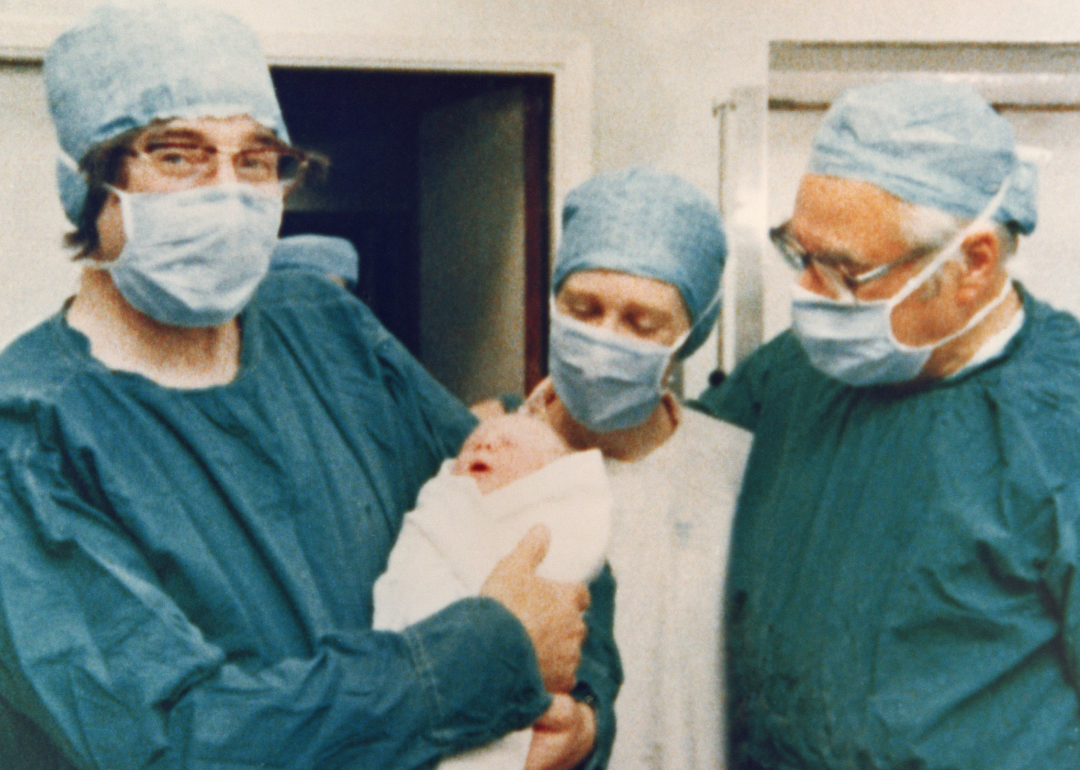
Keystone // Getty Images
The world’s first test-tube baby
Doctors holding baby Louise Joy Brown.
In 1978, the understanding of science and genetics took a huge step forward when the world’s first test-tube baby, a healthy girl named Louise Brown, was born in Oldham, England. Her arrival proved that in vitro fertilization was a safe and feasible option for families who wanted to have children but were otherwise unable to get pregnant.
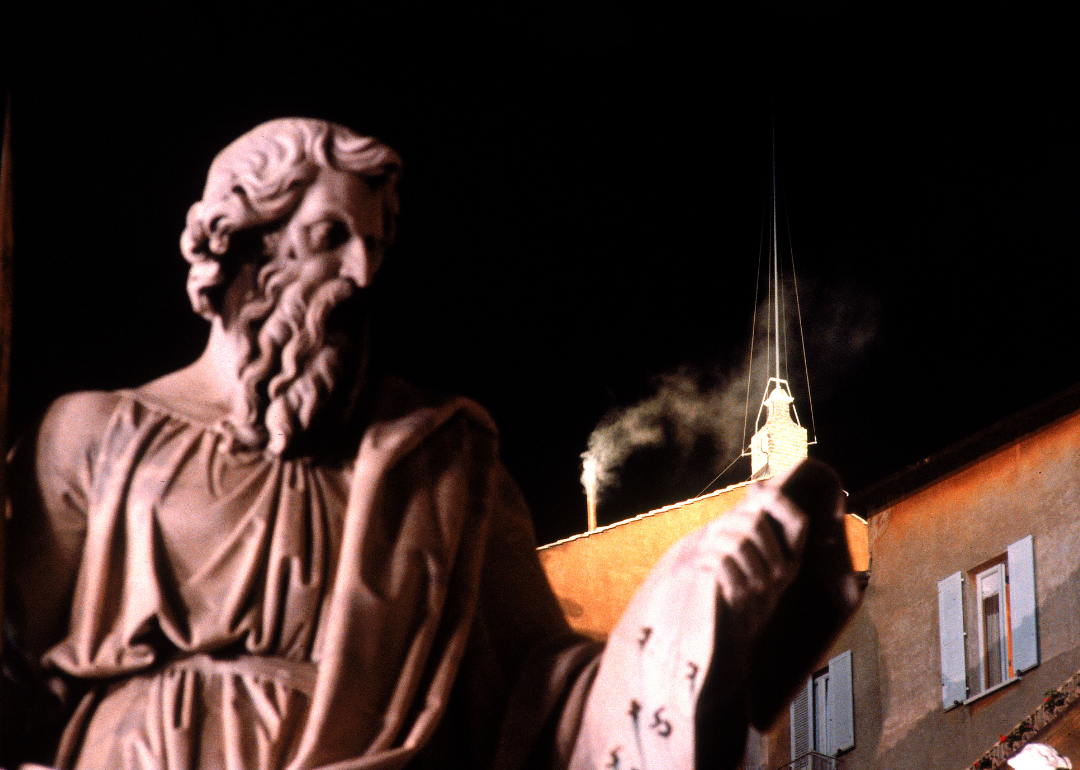
David Lees // Getty Images
World welcomes a new pope
White smoke from the Sistine Chapel chimney at night.
On Oct. 16, 1978, white smoke rose from the Sistine Chapel chimney signaling the election of Pope John Paul II. The first non-Italian pope in 455 years, and the first Slavic pope, he remains the second-longest serving pope in history.
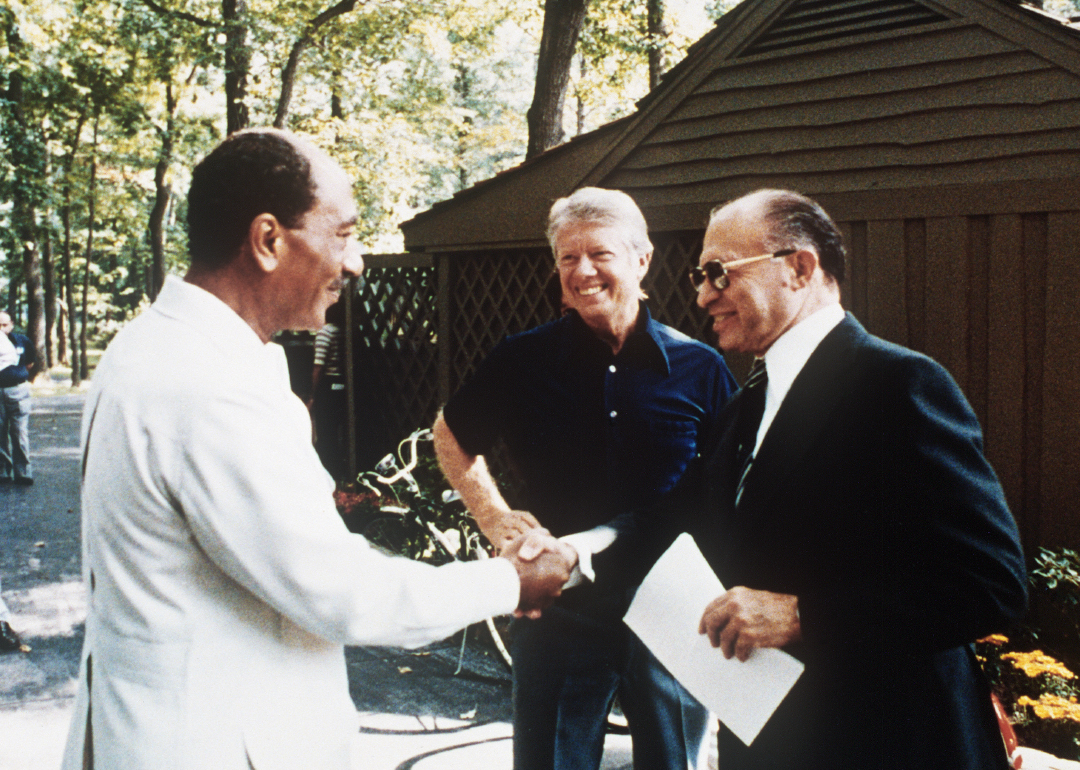
CONSOLIDATED NEWS PICTURES/AFP via Getty Images
The Camp David Accords
President Jimmy Carter at Camp David with Israeli Premier Menachem Begin and Egyptian President Anwar al-Sadat.
In the fall of 1978, President Jimmy Carter, Egyptian President Anwar Sadat, and Israeli Prime Minister Menachem Begin spent 13 days at Camp David in Maryland, coming up with the contents of the Camp David Accords. The two political agreements ended the conflict between the Middle Eastern countries and directly led to the Egypt-Israel Peace Treaty.
You may also like: Popular snacks from your childhood
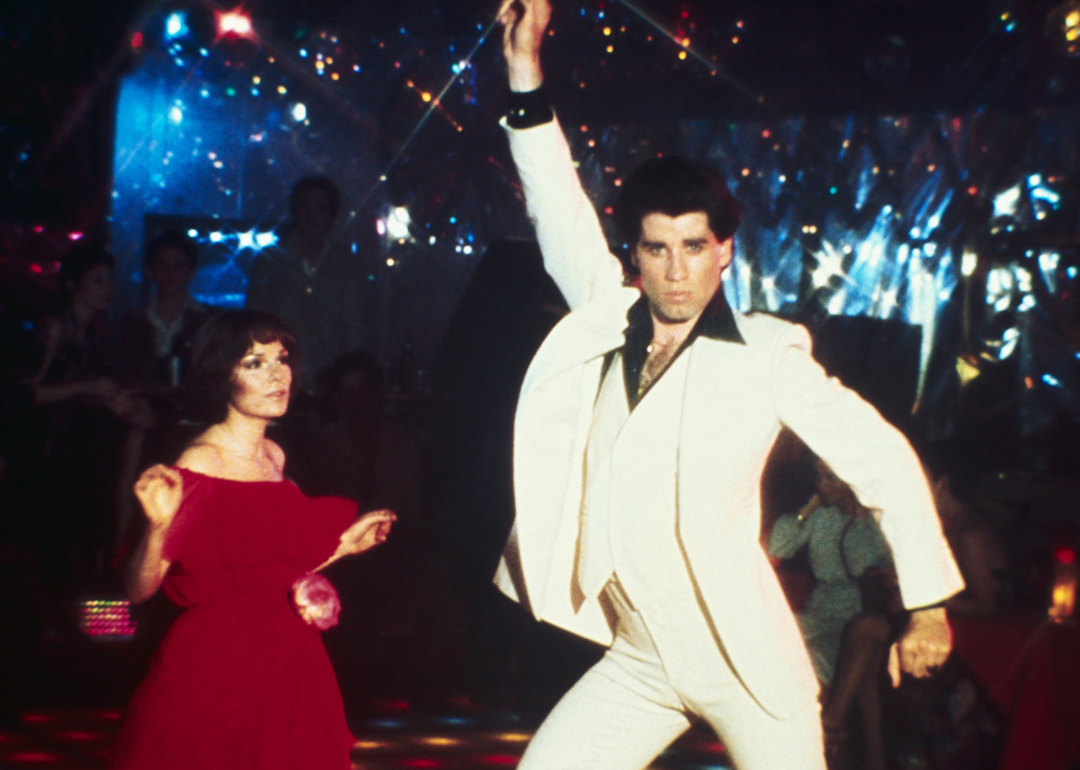
Bettmann // Getty Images
‘Saturday Night Fever’
John Travolta and Karen Gorney in a scene from ‘Saturday Night Fever’.
The John Travolta dance drama “Saturday Night Fever,” released in late 1977, helped extend the life span of the disco scene, which was on its way out at the time. A commercial and critical success, the film—and its soundtrack—not only helped stem the decline of disco but even helped it climb greater heights of popularity in the mainstream.
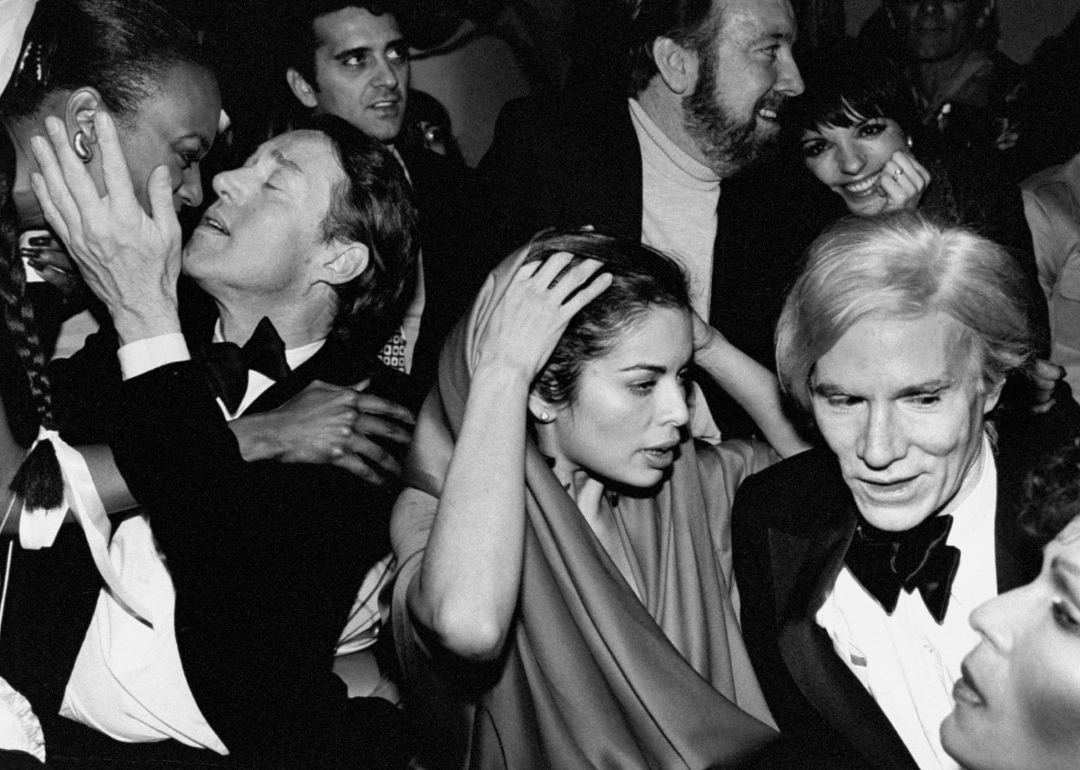
Robin Platzer // Getty Images
The Studio 54 era
Celebrities during New Year’s Eve party at Studio 54.
For four glorious years, between 1977 and 1980, New York City’s Studio 54 club was the epicenter of the country’s nightlife and partying scene. A hedonistic playground where drugs, sex, and alcohol flowed freely and openly, the club was the place to be seen with celebrities like Andy Warhol, Bianca Jagger, Liza Minnelli, and any other big name you could possibly think of, making regular appearances.
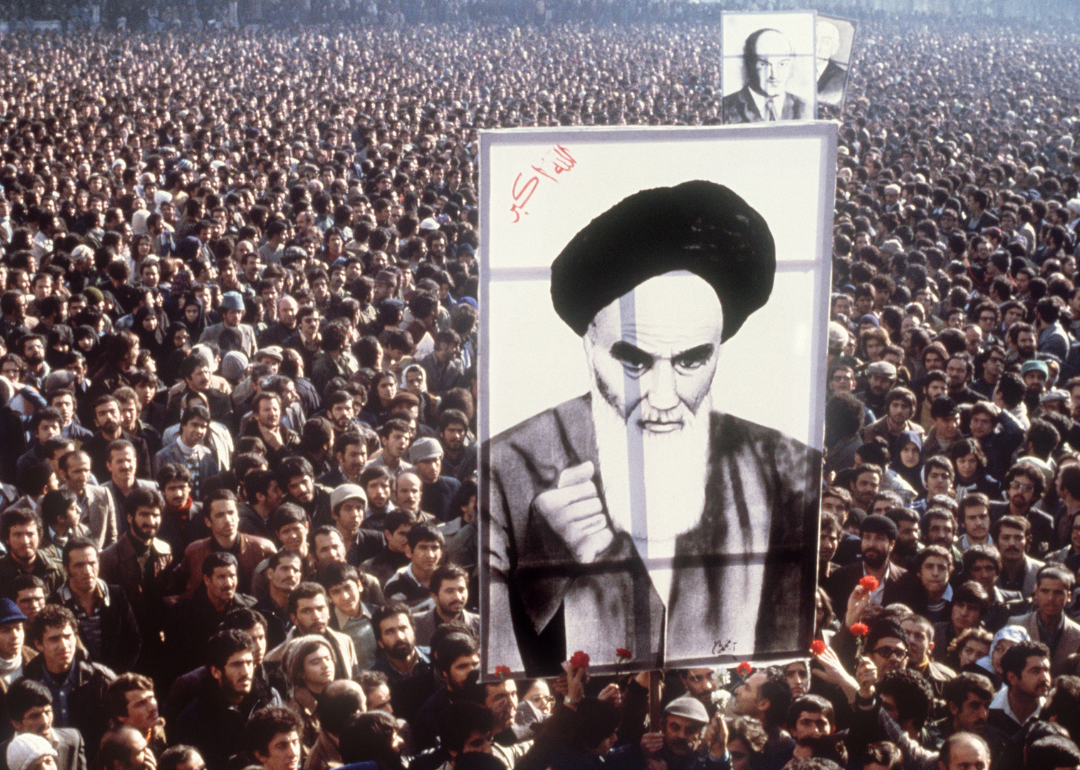
AFP via Getty Images
The Iranian Revolution
Demonstrators hold a poster of Ayatollah Khomeini in Tehran.
In 1979, Iran experienced a massive revolution, turning from a Western-favoring, secular monarchy to an anti-Western theocracy. At the end of the yearlong upheaval, which had a massive effect on international politics, religious cleric Ruhollah Khomeini was put in power.
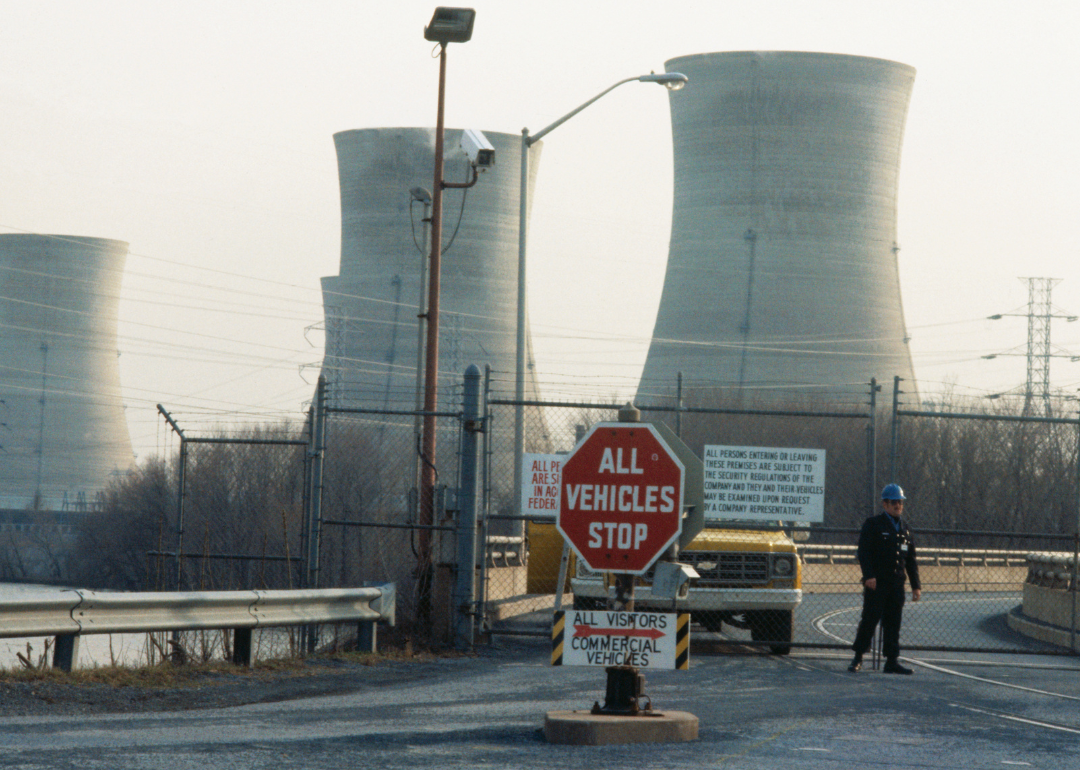
Bettmann // Getty Images
Three Mile Island accident
View of the Three Mile Island nuclear power plant.
In the spring of 1979, the Three Mile Island power plant, located just outside Harrisburg, Pennsylvania, experienced a partial meltdown. Thankfully, the incident did not result in any injuries or deaths, but it did bring about new regulations for the nuclear industry.

James Andanson/Sygma via Getty Images
America strengthens ties with China
Child drinking Coca-Cola on Great Wall of China.
The United States’ ties with China are among the most important political and diplomatic relationships in existence. After President Richard Nixon visited the formerly communist country in the early ’70s, much progress was made in the once-frosty relationship between the nations. That progress extended beyond the political realm, edging into arenas such as education and culture. Since then, relations have become fraught, with many dubbing it the “new Cold War.”
You may also like: What 50 American cities looked like 100 years ago
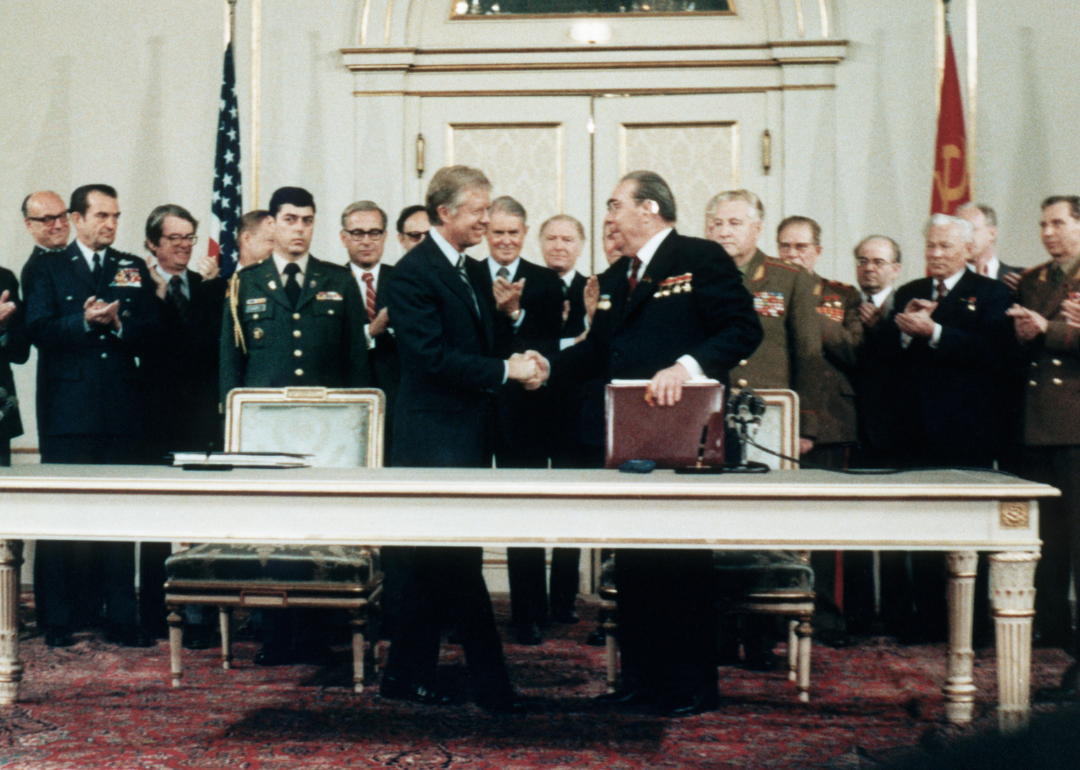
CORBIS/Corbis via Getty Images
The SALT II treaty
President Jimmy Carter and Leonid Brezhnev shake hands.
At the end of the decade, an American president, this time Jimmy Carter, once again met with a Soviet leader, Leonid Brezhnev, to sign another nuclear treaty. One of the most controversial agreements of the entire Cold War, the treaty aimed to resolve numerous issues left unaddressed by the Strategic Arms Limitations Treaty I, like limiting the number of multiple independently targetable reentry vehicle missiles that could be produced. By Christmas 1979, the Soviets invaded Afghanistan, and thus SALT II was never ratified.

Bettmann // Getty Images
Drops of Jupiter
Close view of Jupiter seen from Voyager 2.
In 1979, NASA sent two spacecraft, Voyager 1 and Voyager 2, to get images of Jupiter. Together the spaceships took more than 33,000 highly detailed images of the planet and five of its major satellites, expanding the understanding of the universe by leaps and bounds.
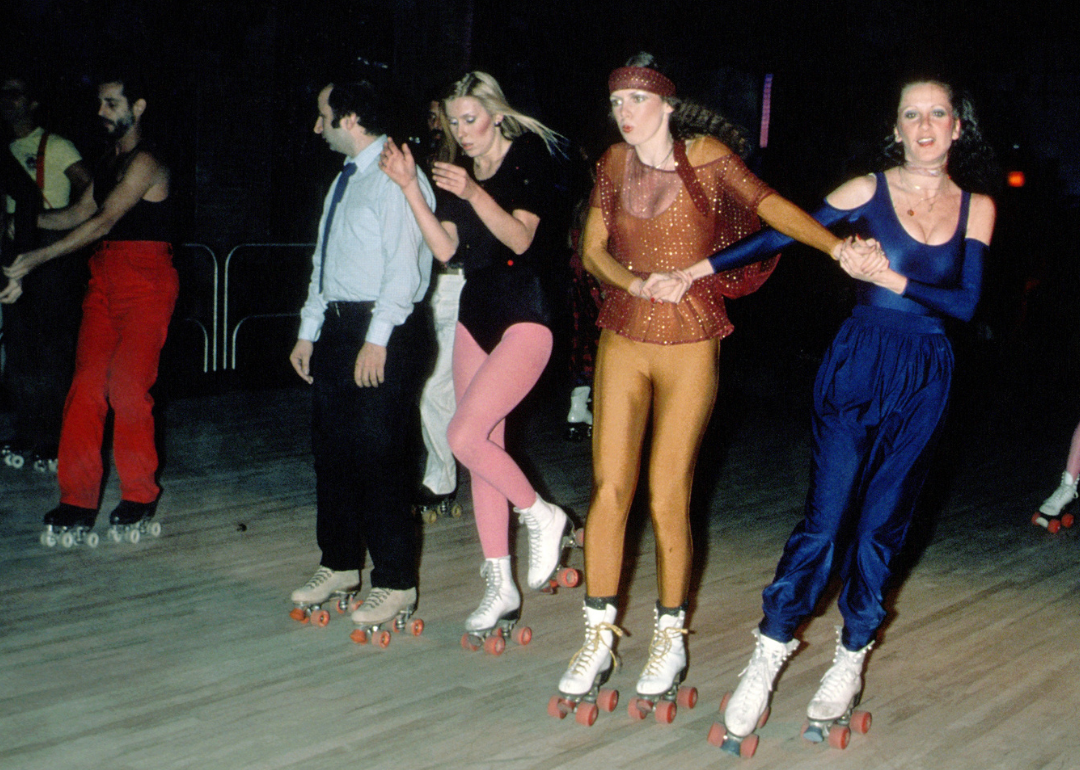
PL Gould/Images // Getty Images
Roller discos
People roller skating indoors.
Roller skating was a hugely popular leisure activity in the 1970s. For the adult crowd, roller discos, which combined the activity of skating with the music and vibes of a disco, was a popular nightlife option.
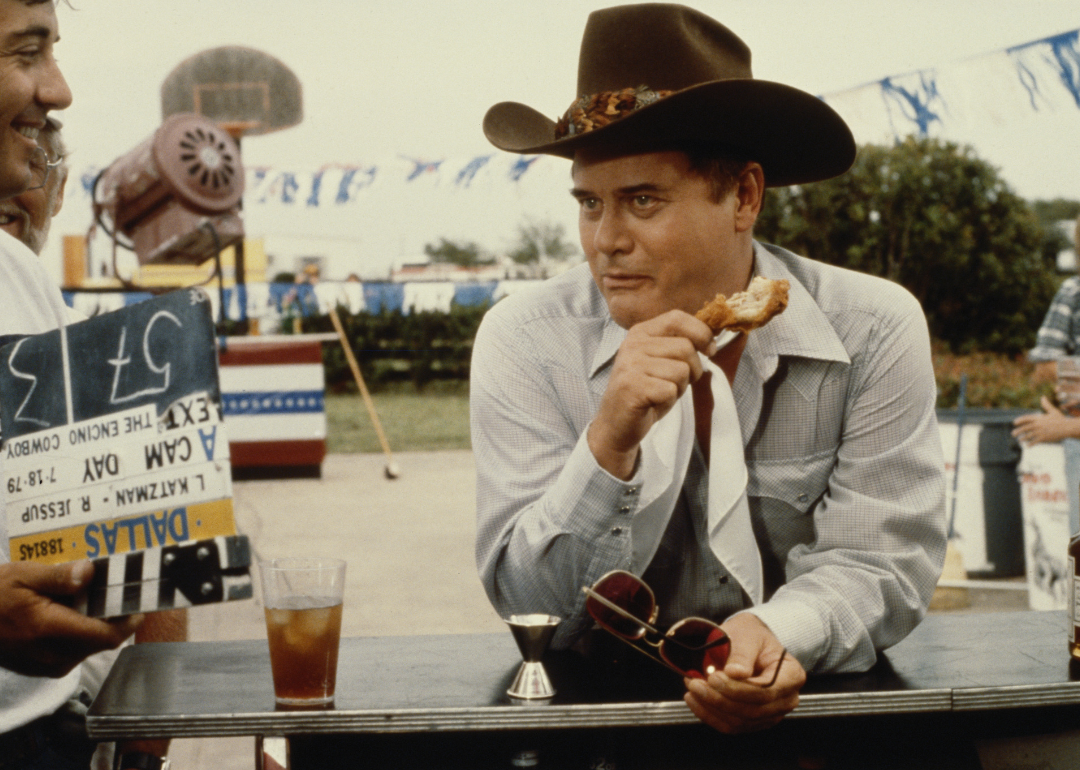
Maureen Donaldson // Getty Images
‘Dallas’
Actor Larry Hagman on the set of ‘Dallas’.
Though “Dallas” really got big in the ’80s, the campy TV prime-time soap opera actually premiered in 1978. Centered around a feuding oil family, the Ewings, the show was known for its cliffhanger endings, over-the-top plotlines, and huge viewership numbers.
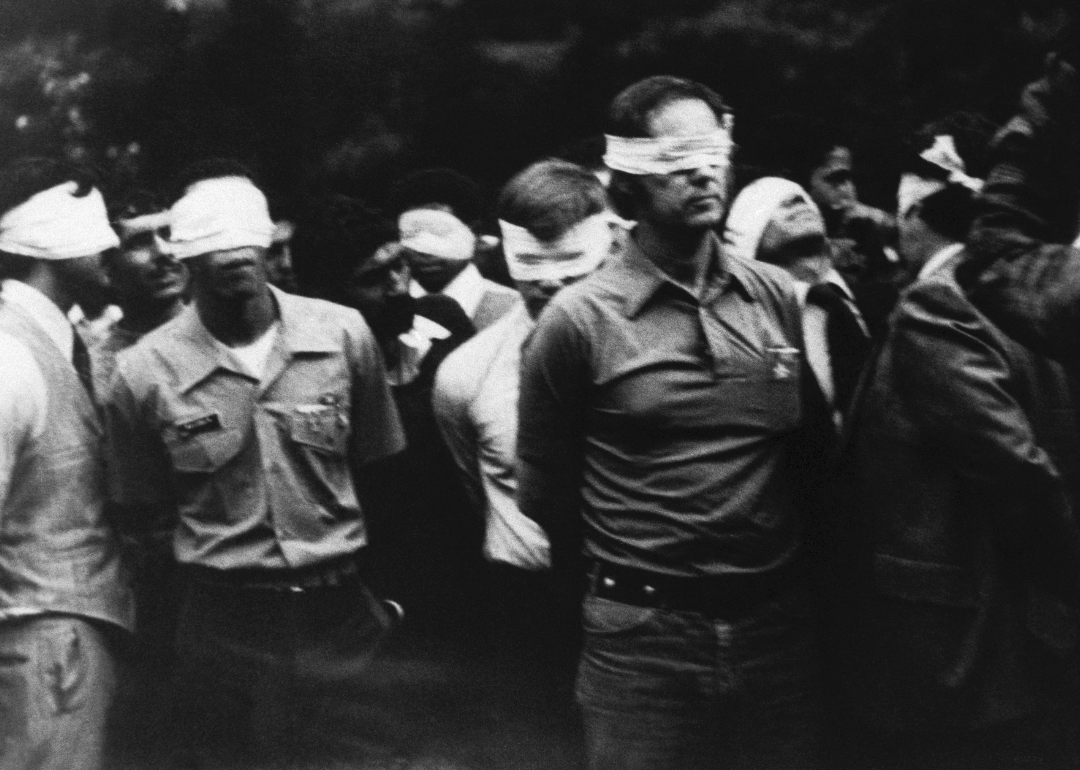
Bettmann // Getty Images
The Iranian hostage crisis
Blindfolded hostages outside US Embassy.
In an event that attracted the attention of the world, more than 50 Americans were taken hostage at the U.S. Embassy in Tehran, Iran, on Nov. 4, 1979, by a group of Iranian students who supported the revolution. The hostages were held for 444 days, despite several rescue attempts, and only released when Ronald Reagan was inaugurated as the next U.S. President on Jan. 20, 1981.
You may also like: 30 toys that defined the ’80s
